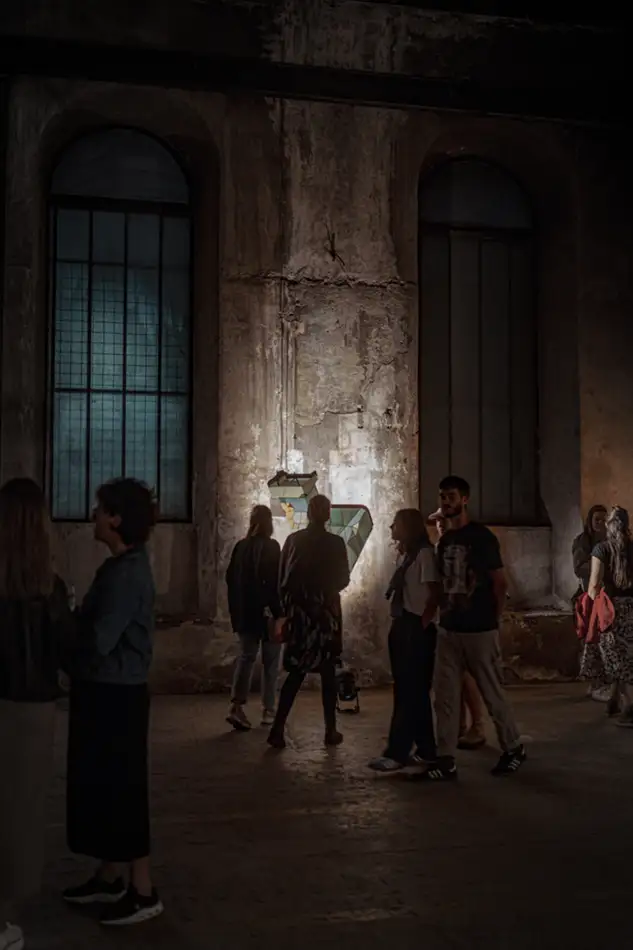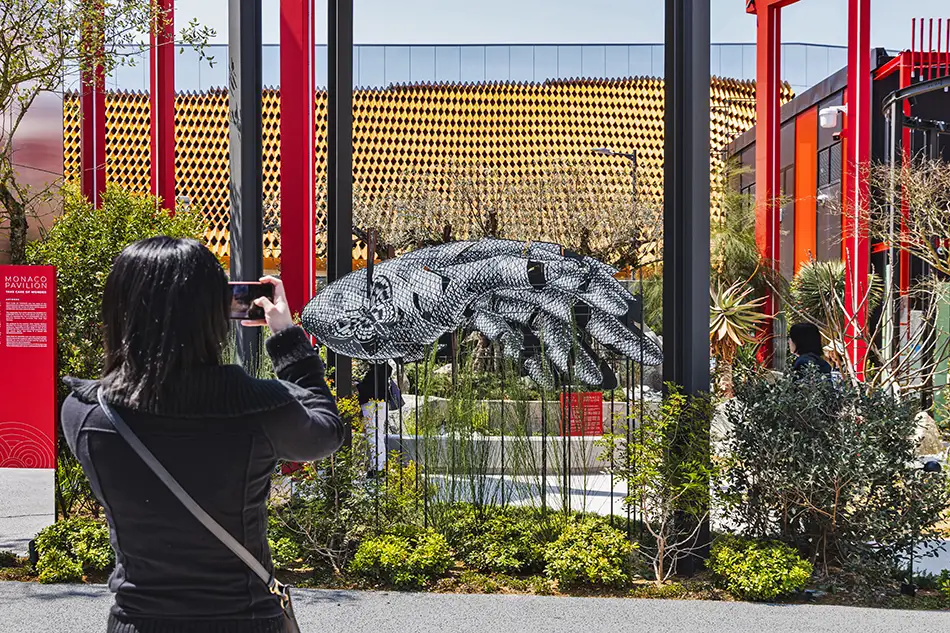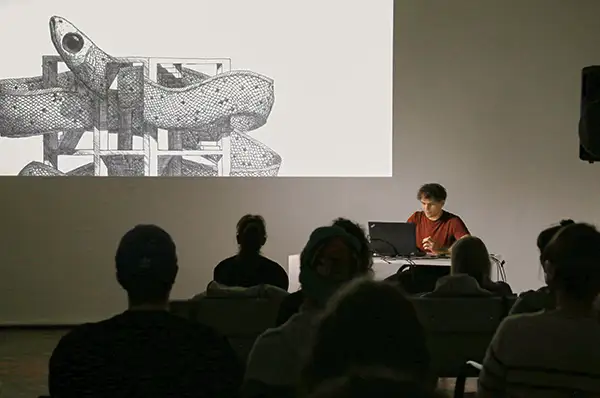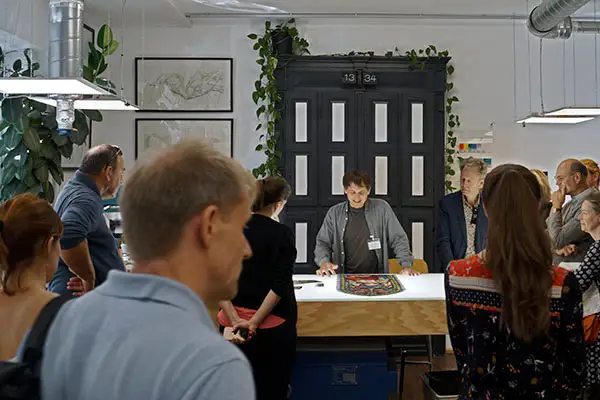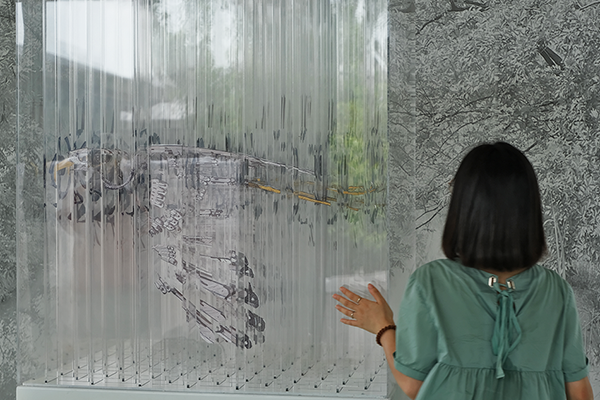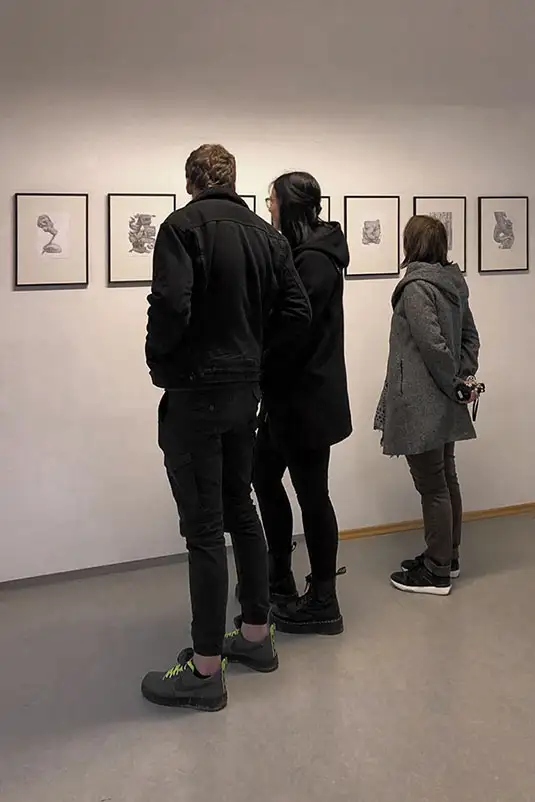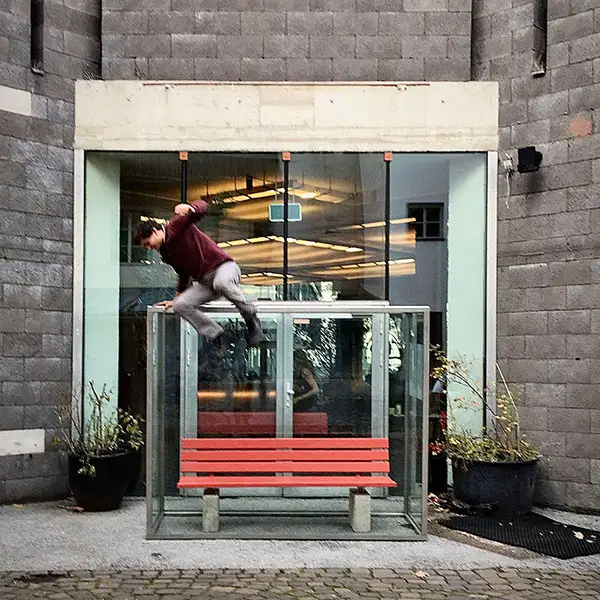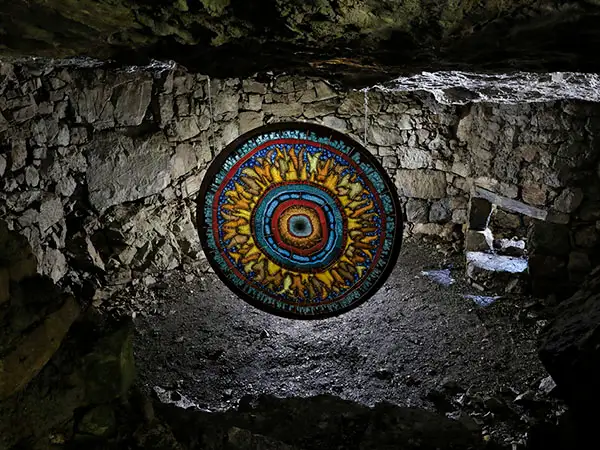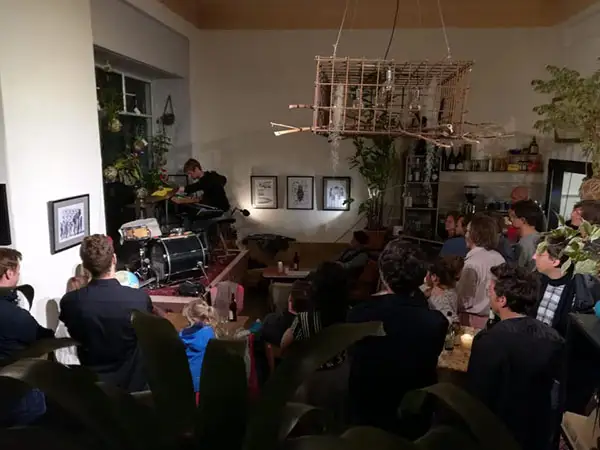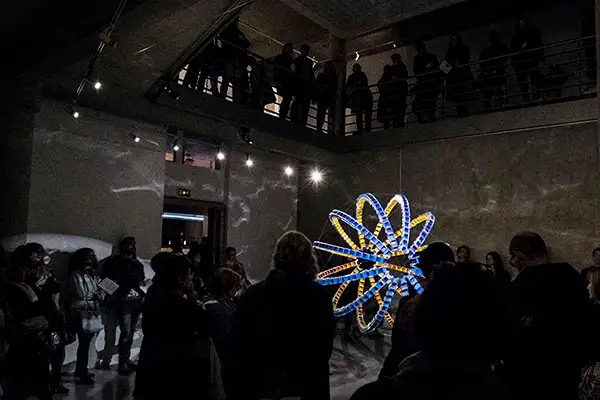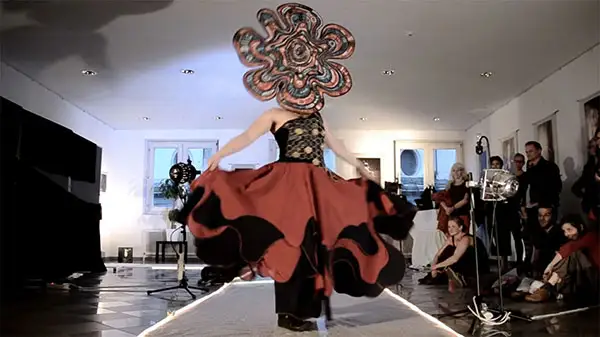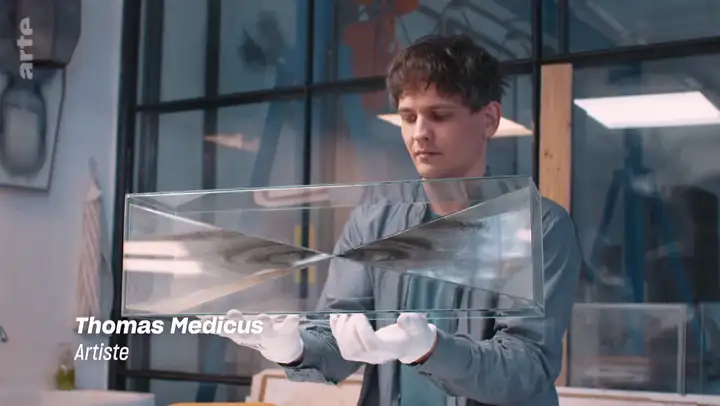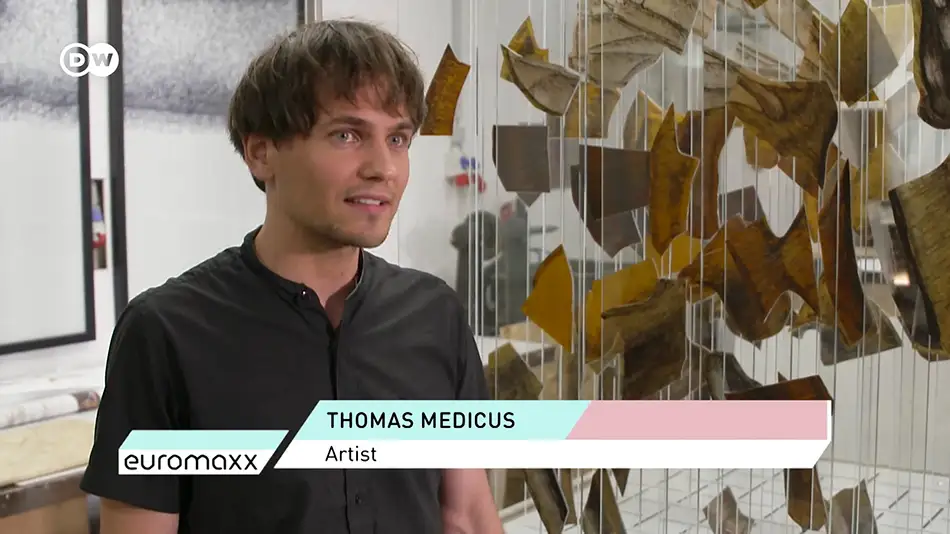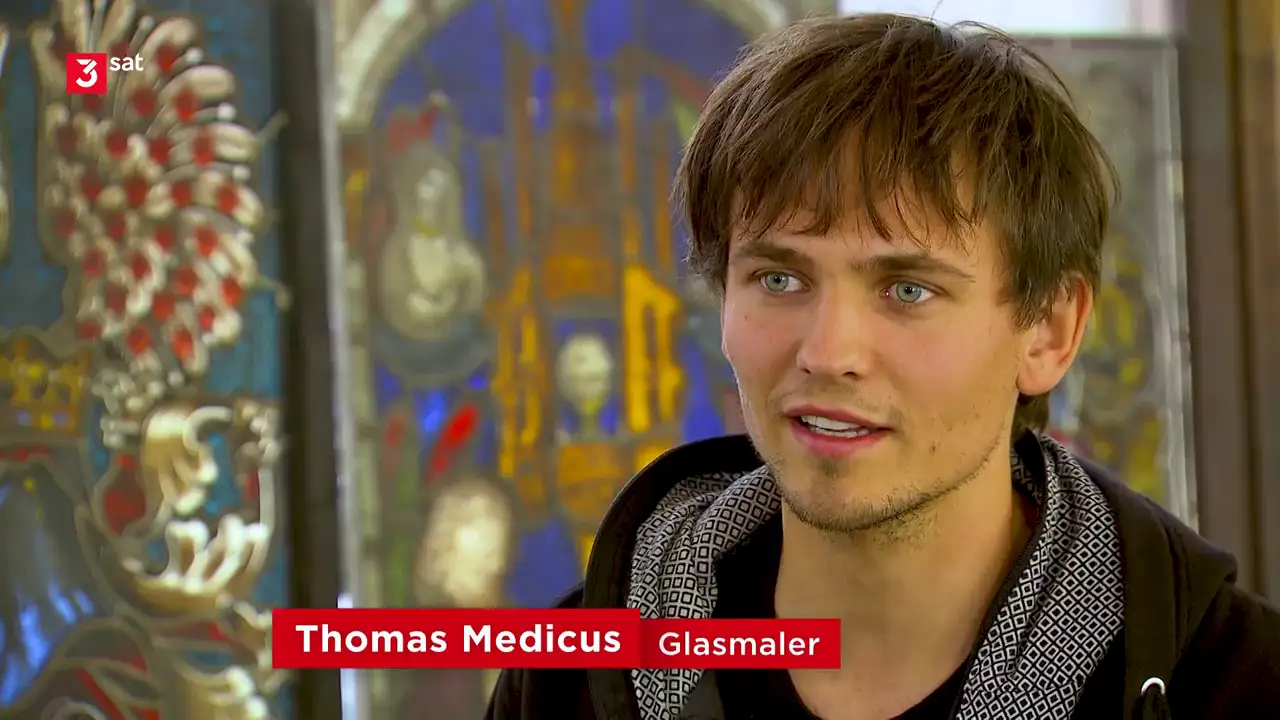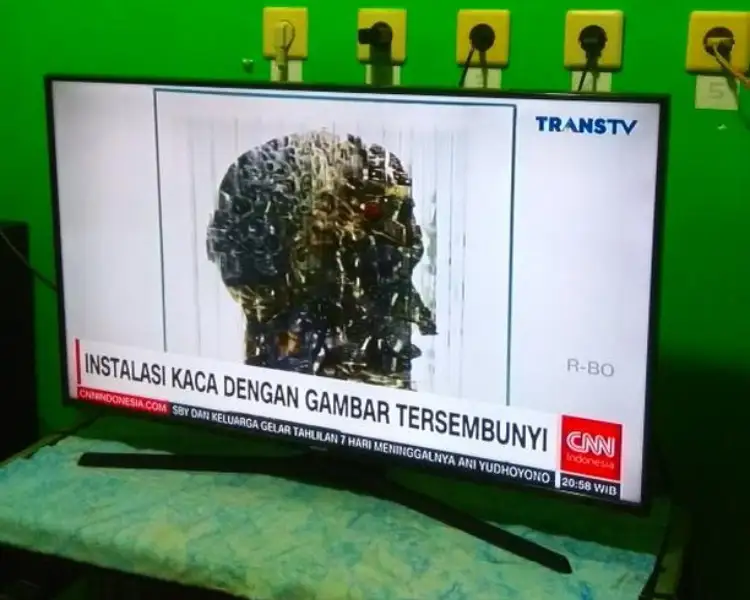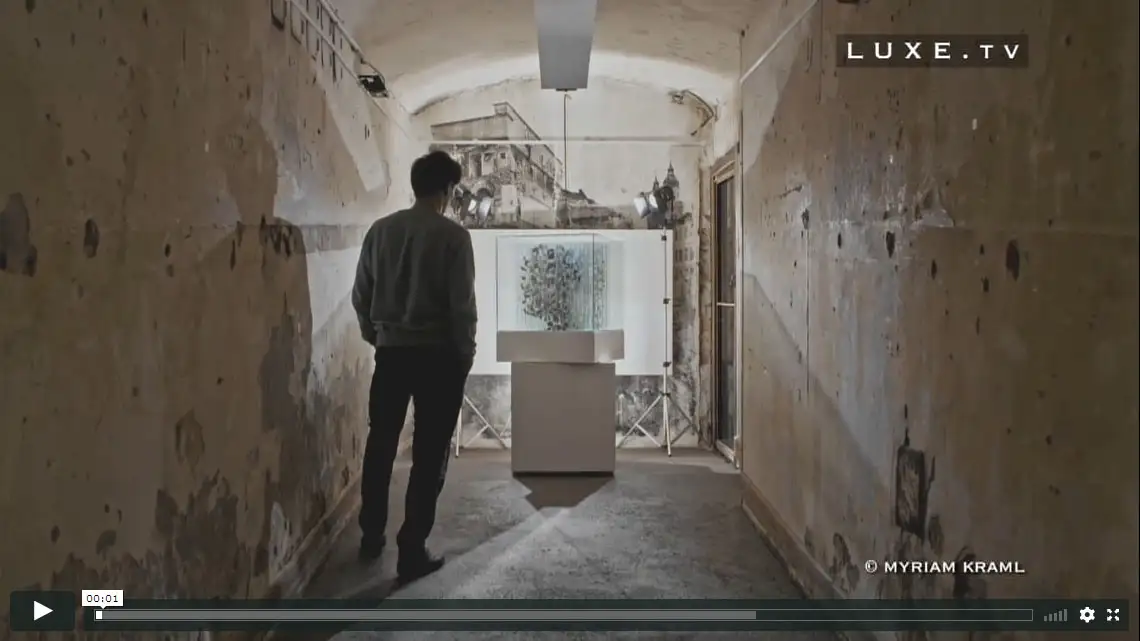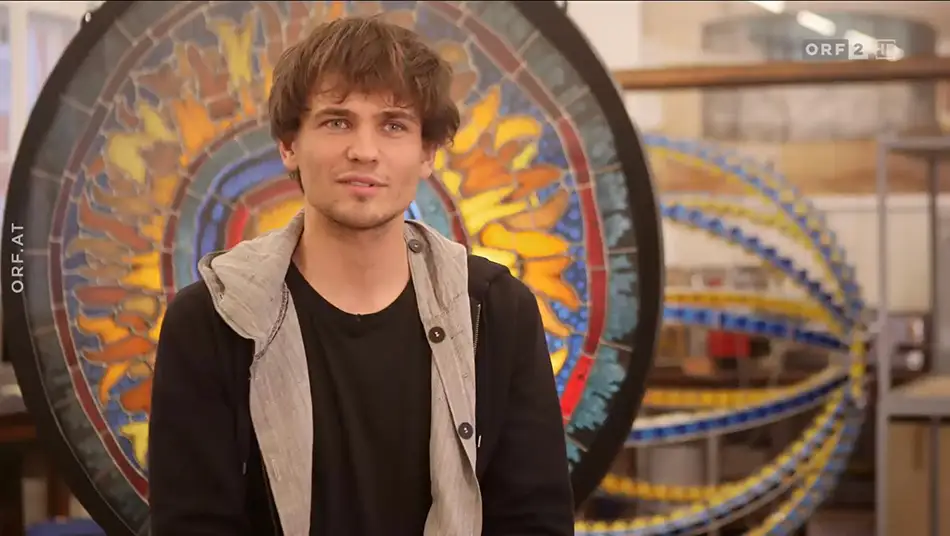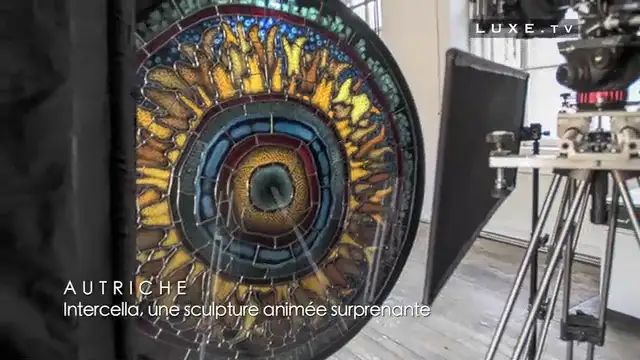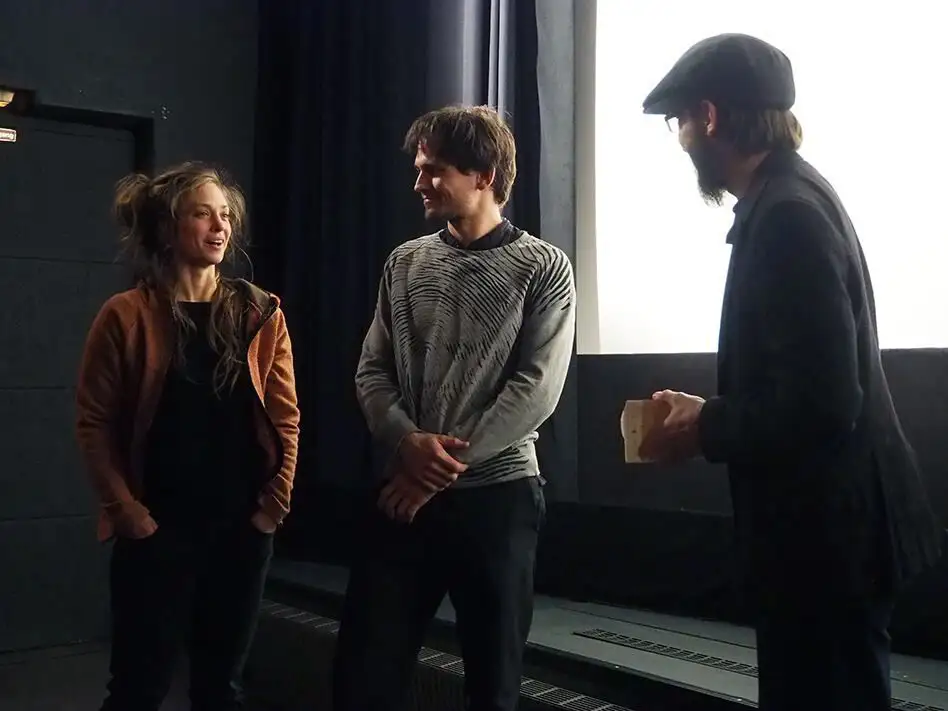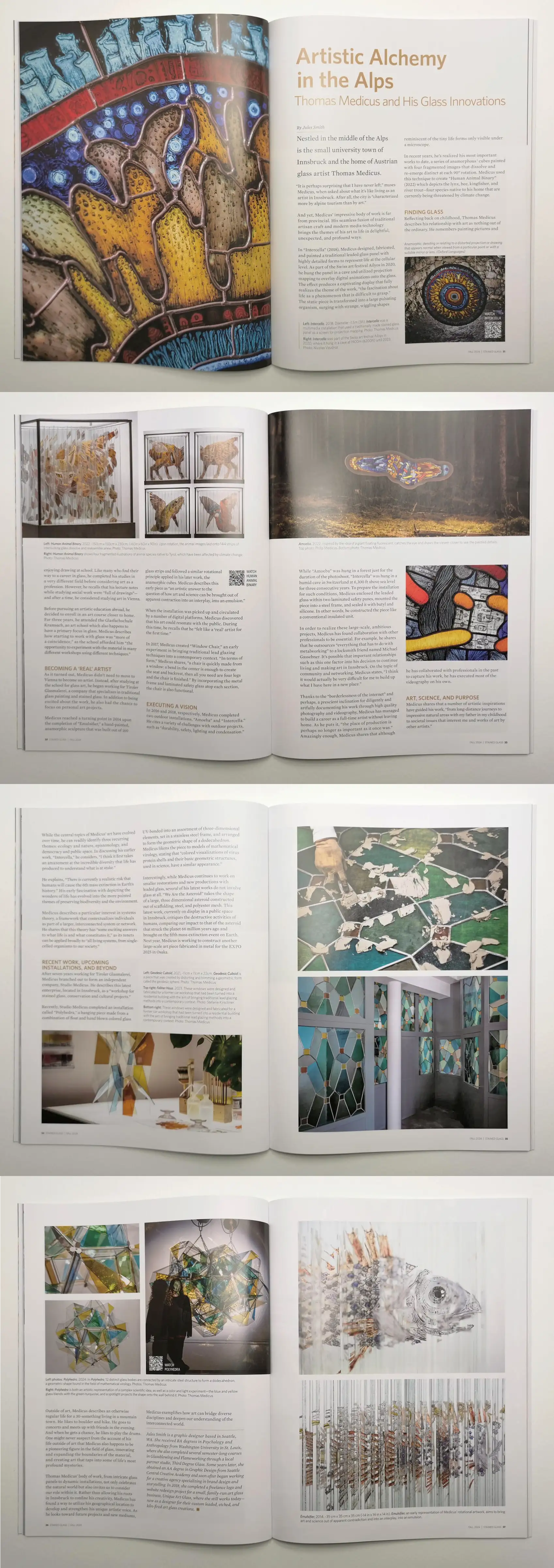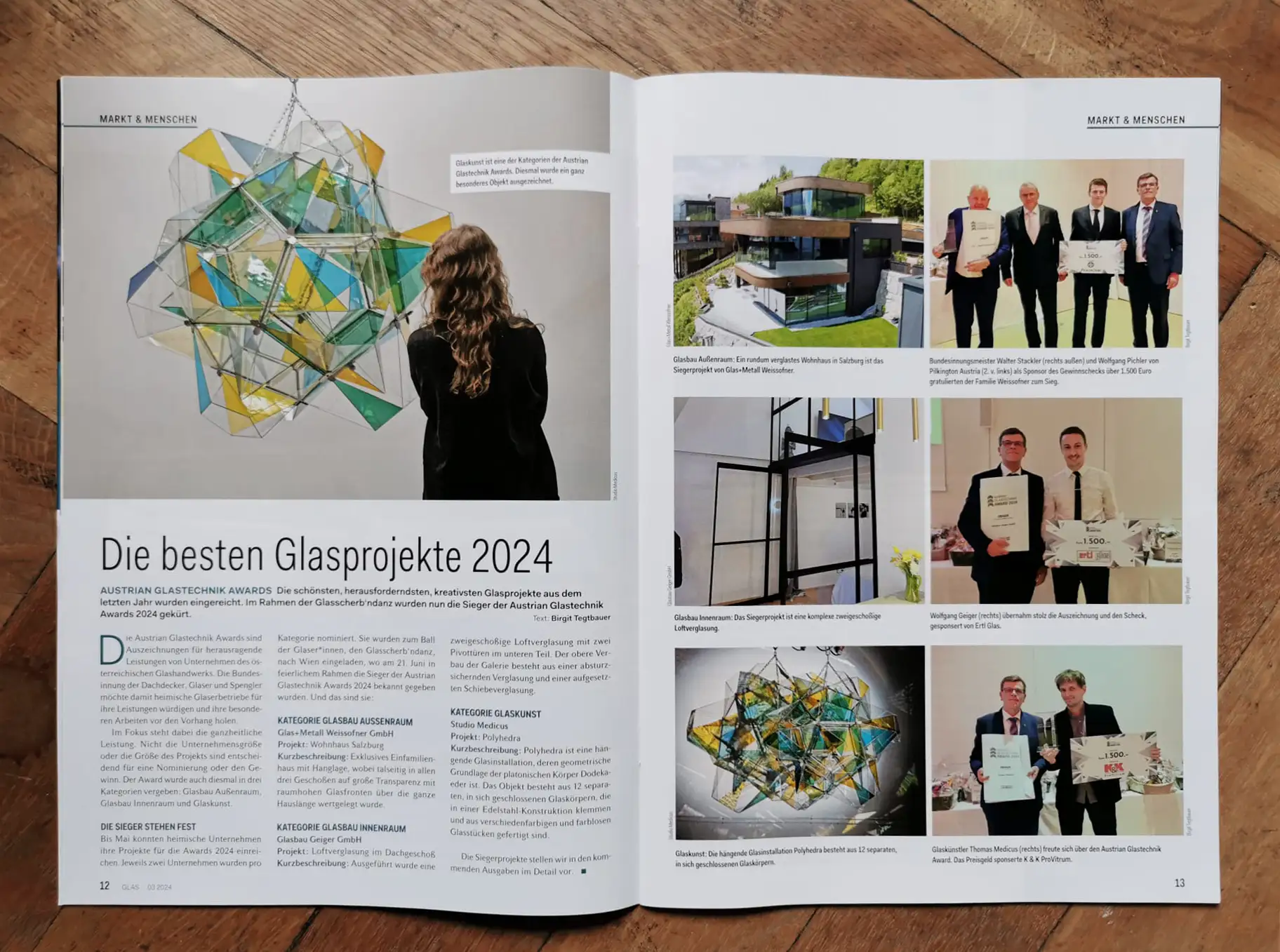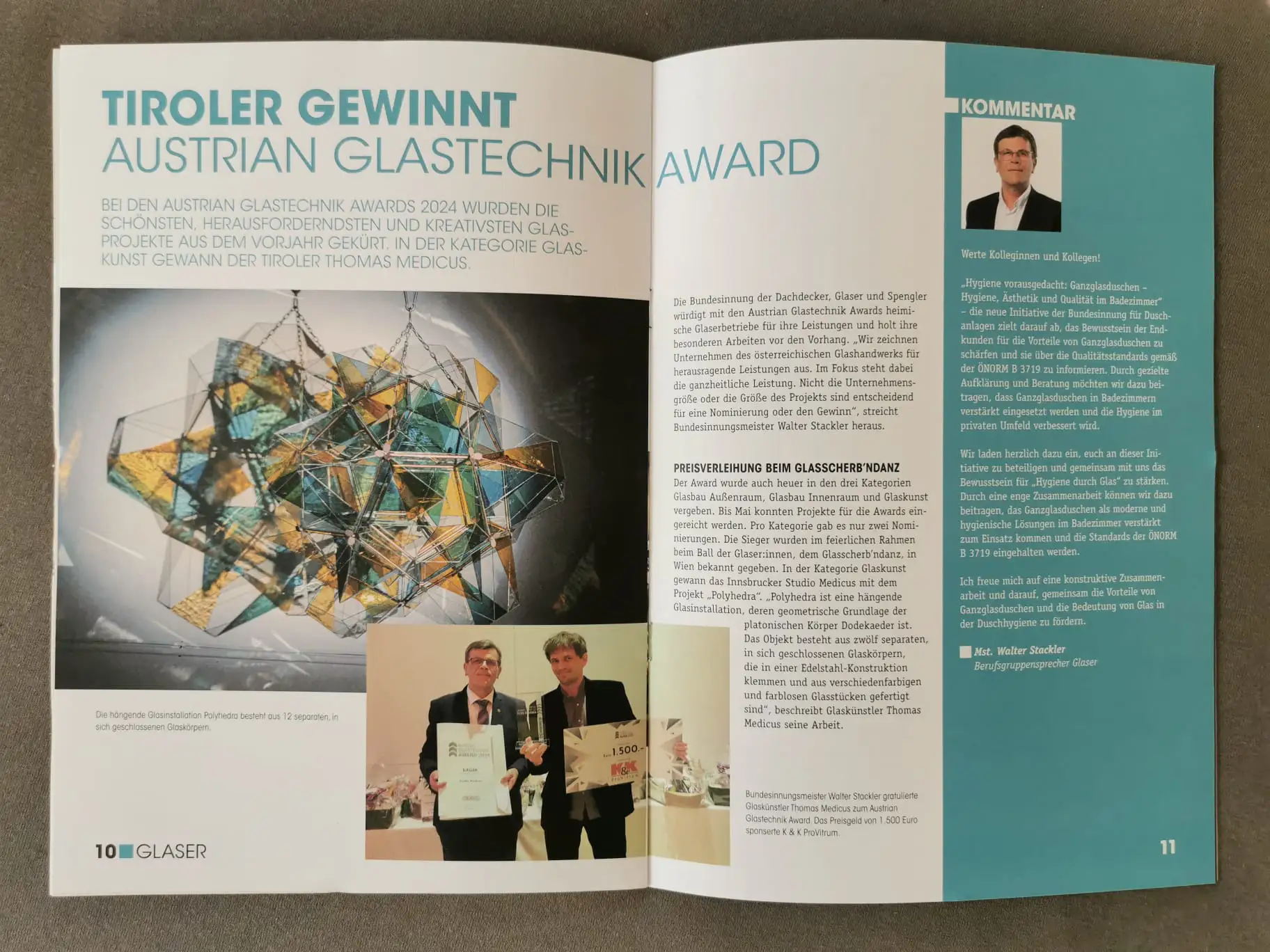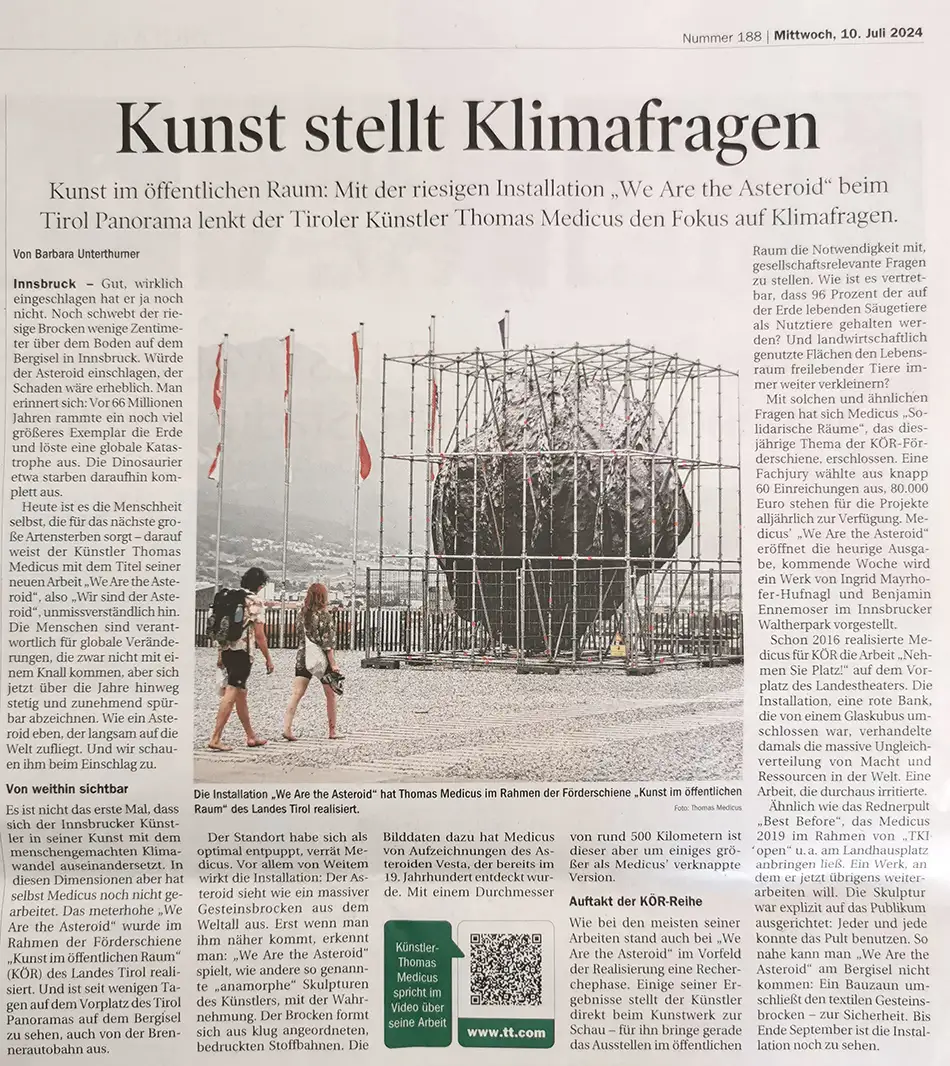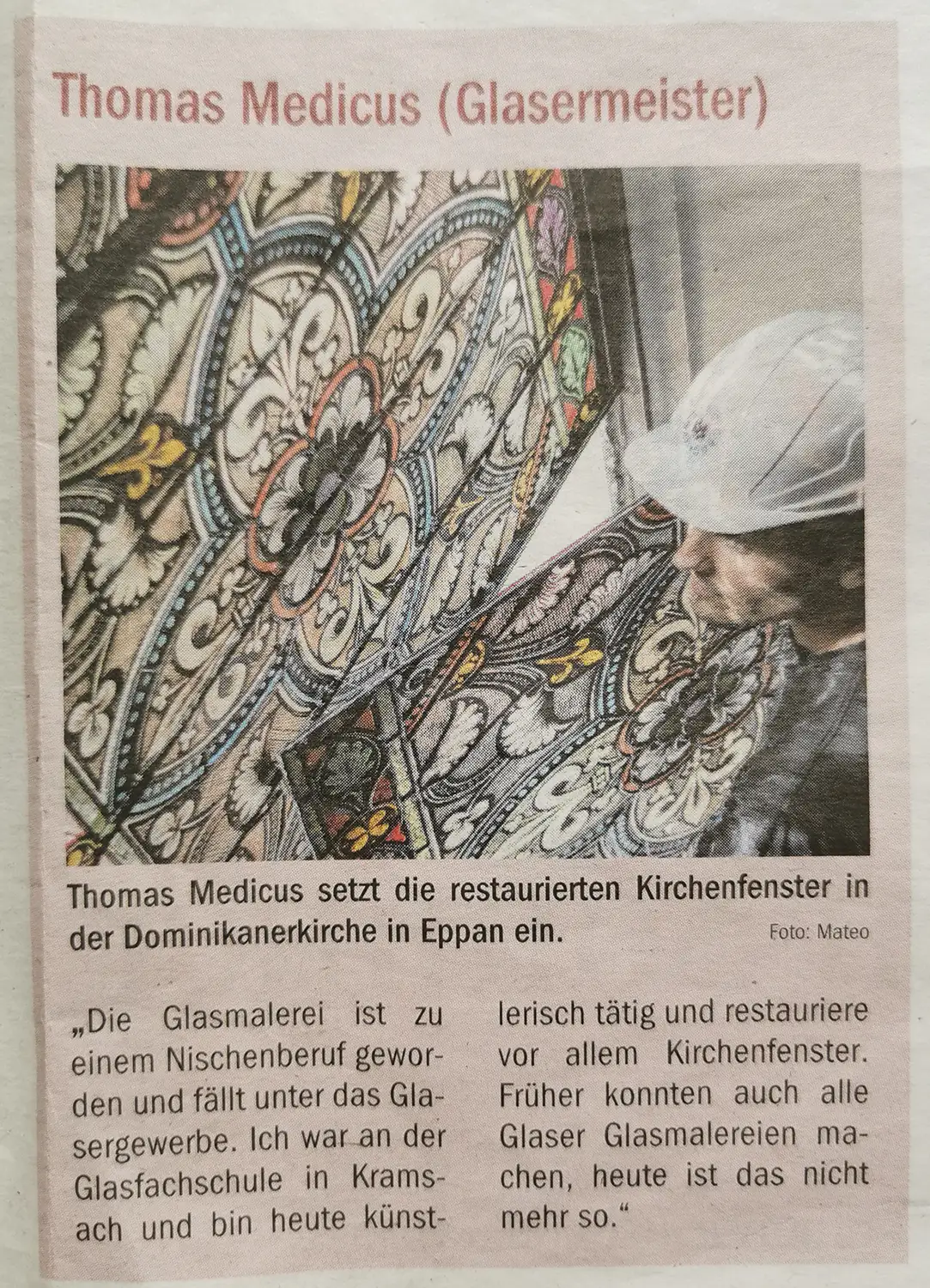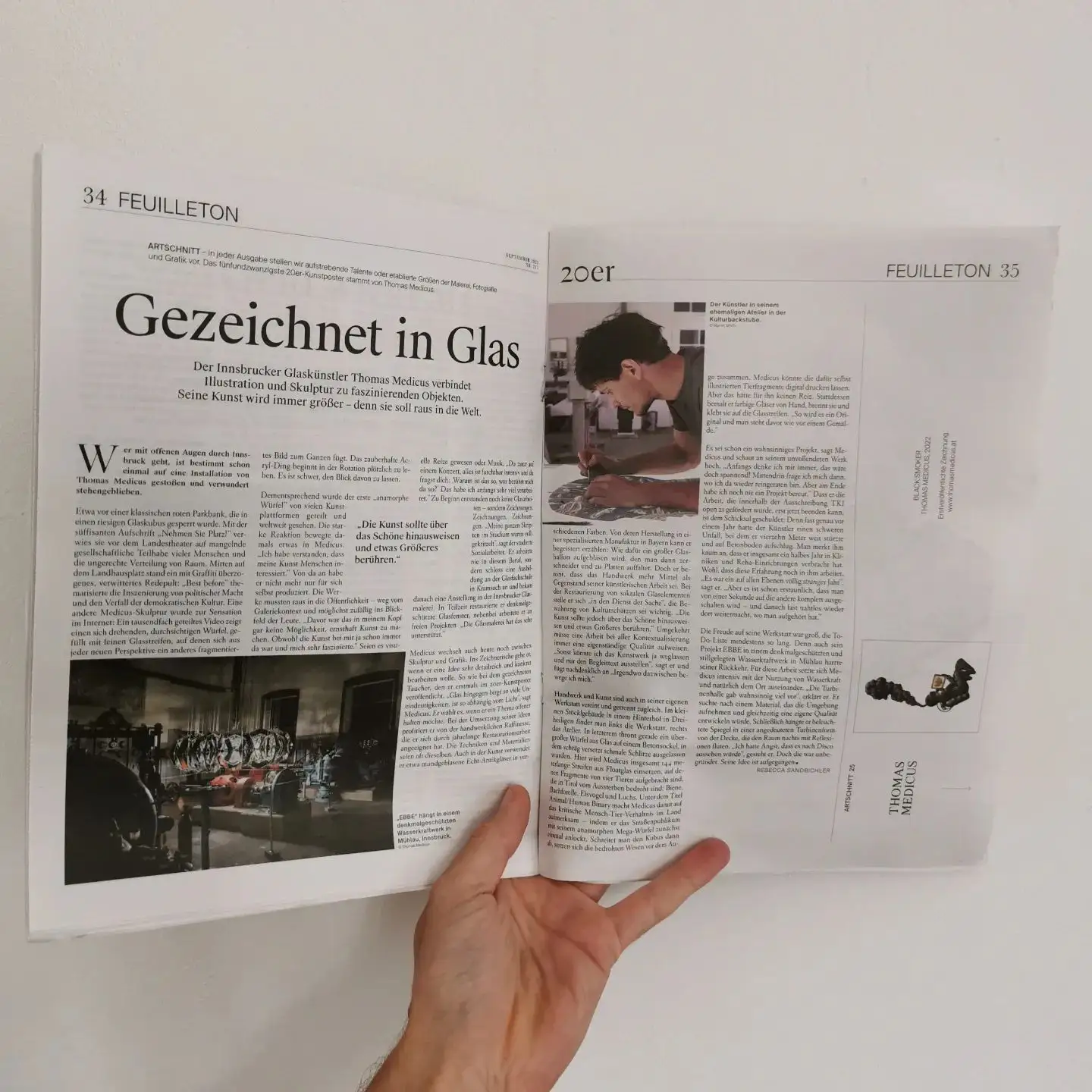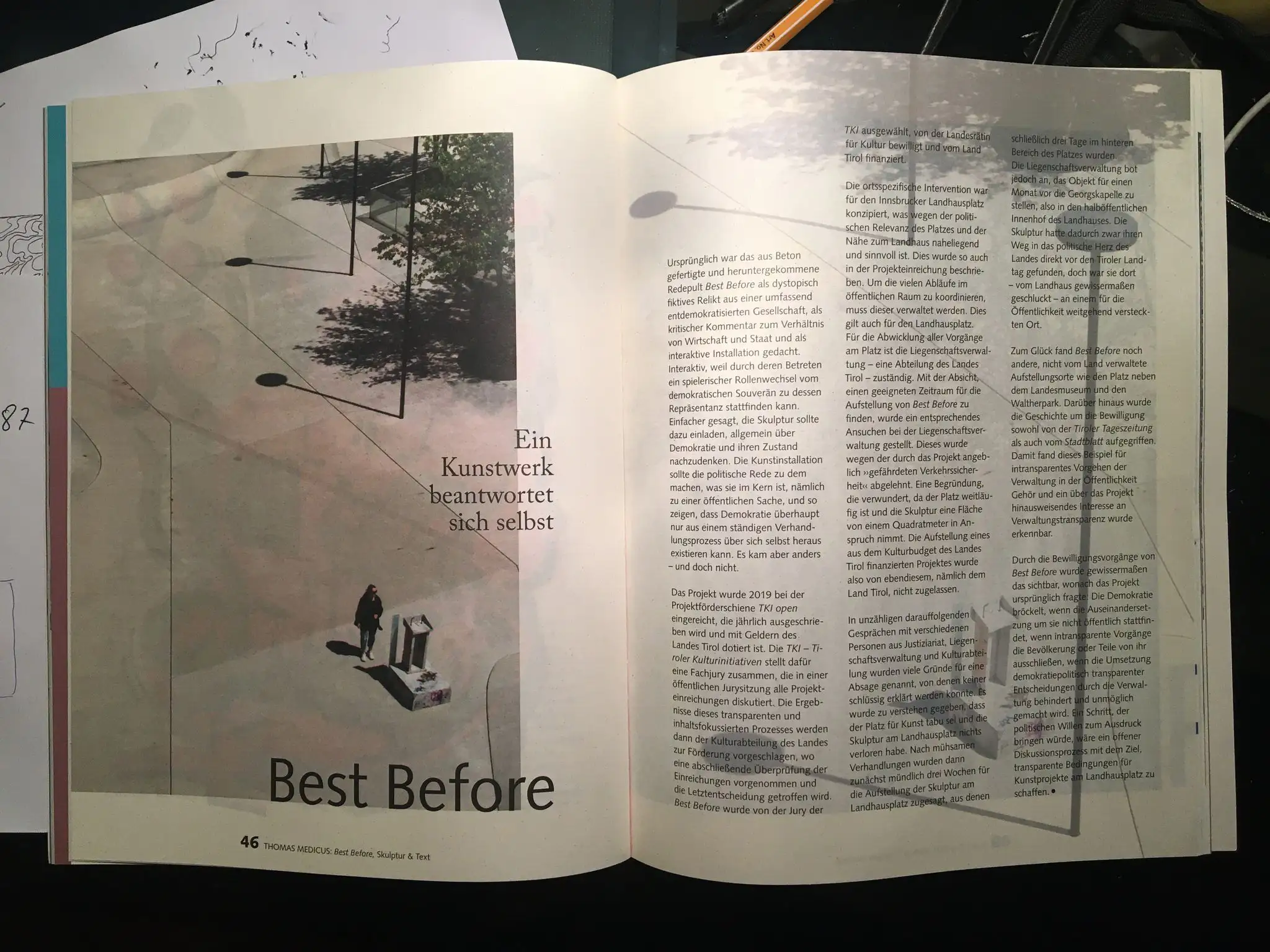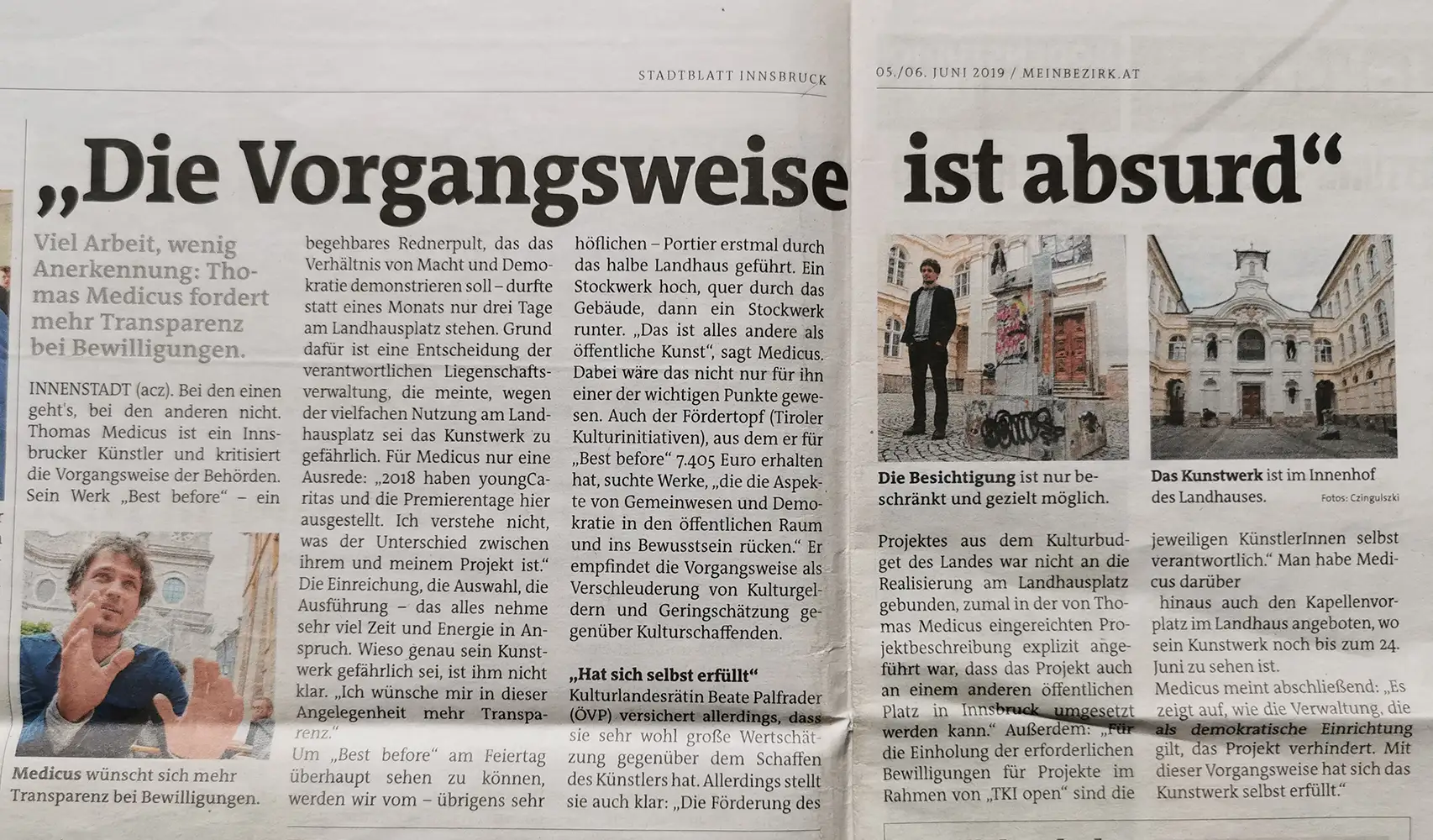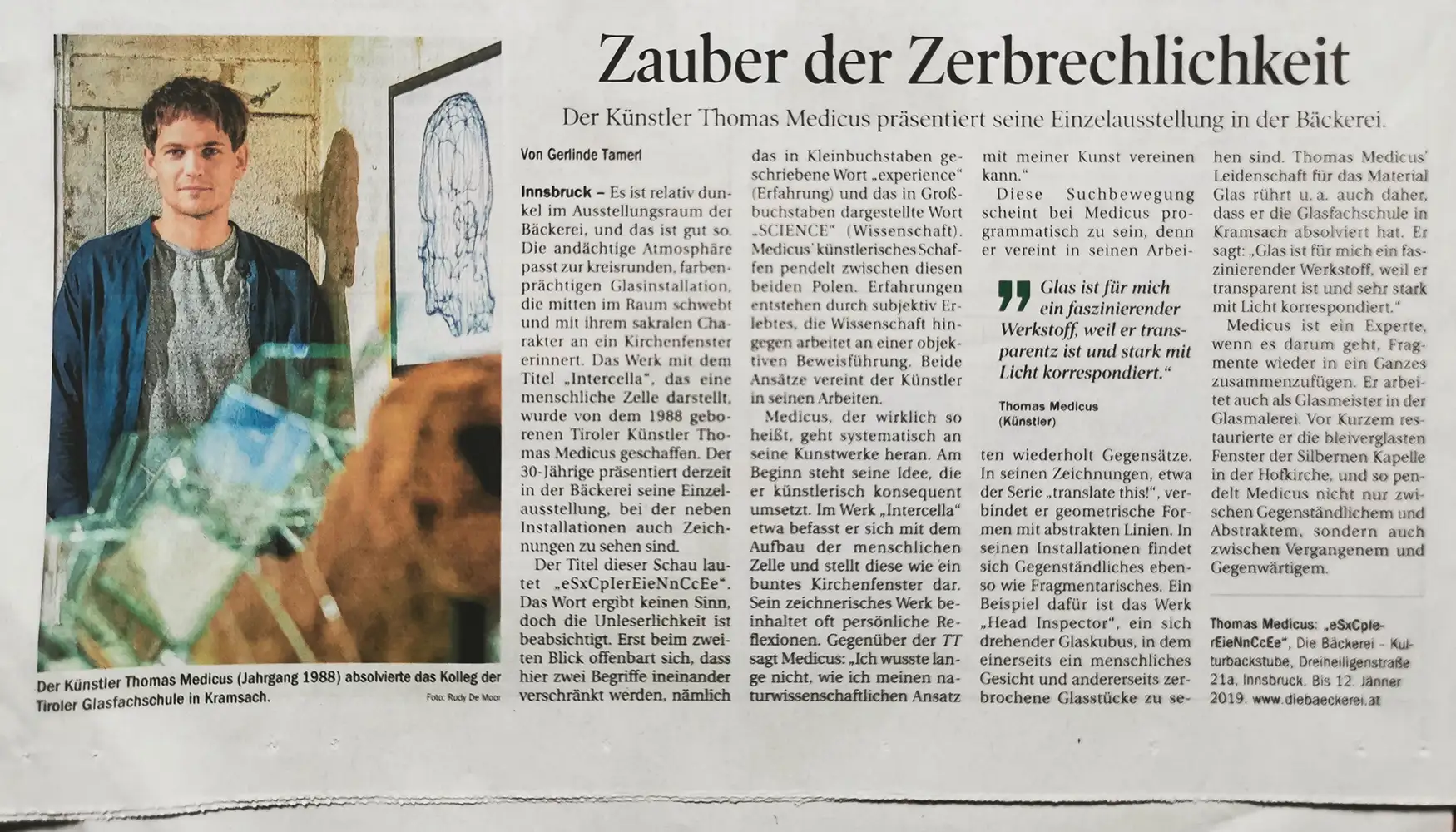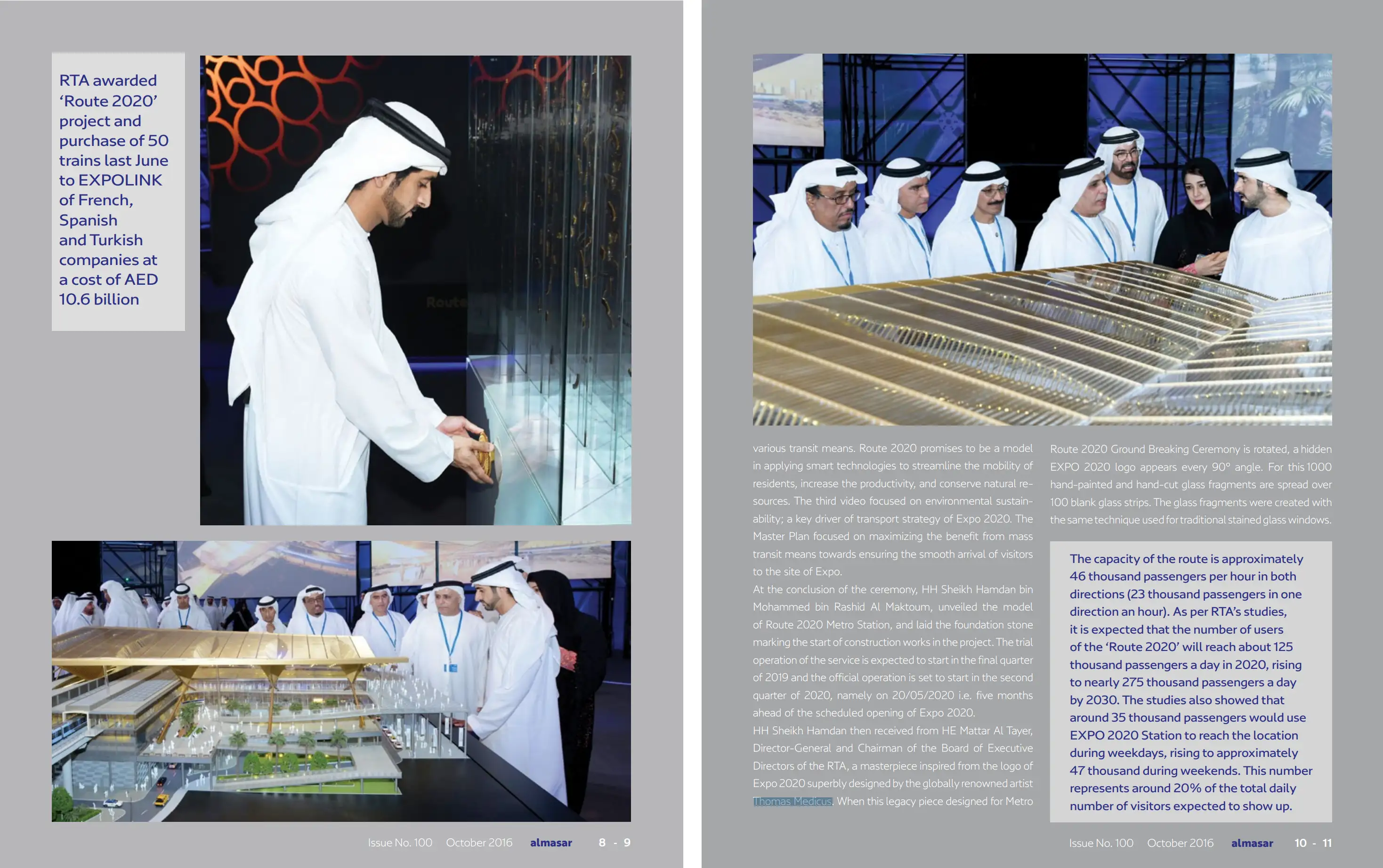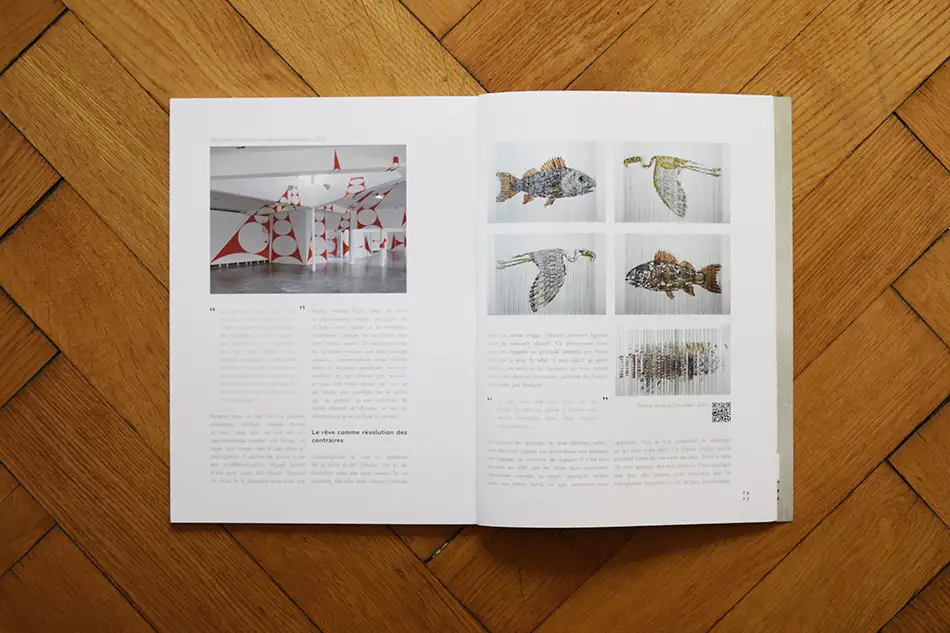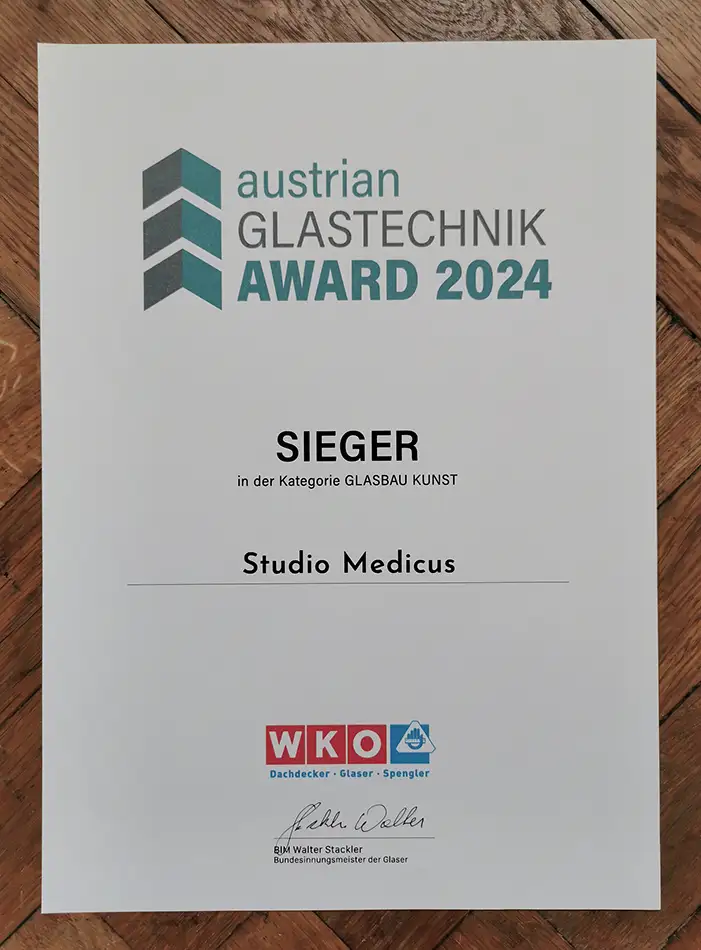
Thomas Medicus *1988 is a visual artist based in Innsbruck, Austria. Best known for his anamorphic cubes he also works in other fields such as illustration, animation, digital art, stained glass, restoration and conservation as well as public art. He studied social work at MCI Innsbruck before attending the Glasfachschule Kramsach, a school for glass art, where he earned a master glaziers degree later. In addition to his independent activity as a freelance artist, he was employed in the long-standing firm for stained glass windows Tiroler Glasmalerei for seven years. From the beginning of 2021 he became completely independent and founded his company Studio Medicus.
Medicus is a member of the Künstler*innen Vereinigung Tirol as well as the Kollegium Glasmalerei Österreich.
Exhibitions / Installations / Events
2025 Polyhedra, Das Wundervoll Coworking, Innsbruck

2025 EYEEYE, Boutique Vacheron Constantin, Geneva
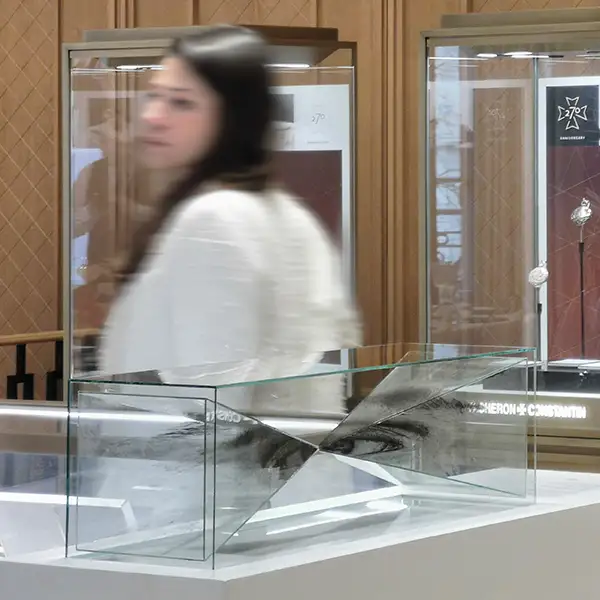
2025 Human Animal Binary, IAM Illusion Art Museum, Prague

-cornelia-reinisch-hofmann.webp)
2024 We Are the Asteroid, Tirol Panorama, Bergisel Innsbruck
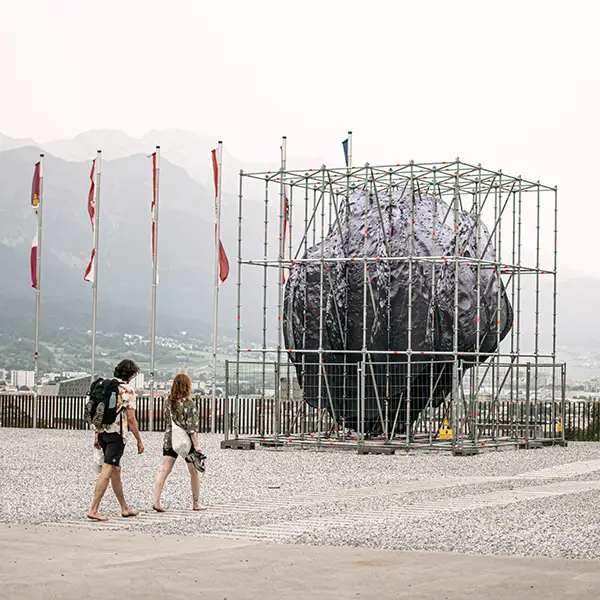
2024 Human Animal Binary, Cafe im Grünen at Wohnheim O-Dorf, Innsbruck

2024 Ecotopia, Tag zum Schutz der Alpen, Studio Aria Sadr-Salek, Innsbruck

2023 Human Animal Binary, Glaszeit, Hungerburg Innsbruck

2023 Black Smoker, Schauhaus Innrain 21, Innsbruck
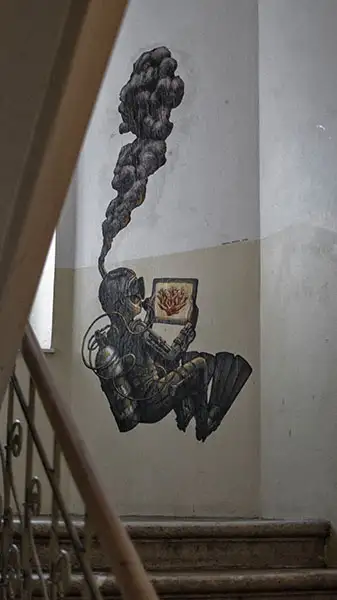
2023 Intercella, Drei Heiligen Gestalten, Innsbruck
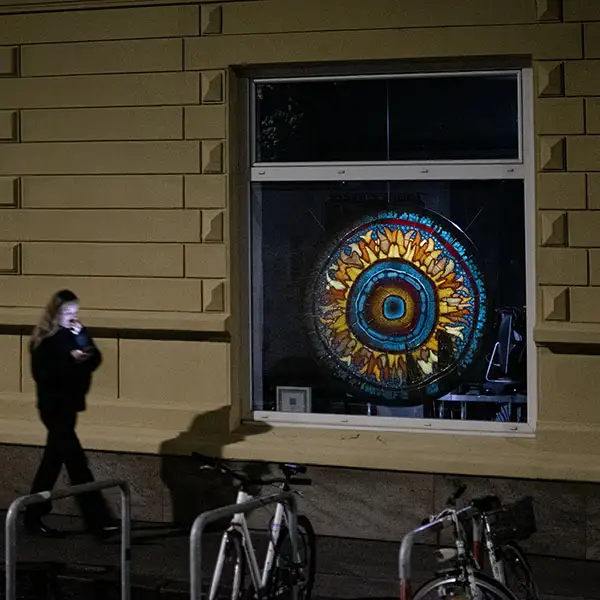
2023 Charity art auction, Rotary Club Innsbruck-Alpin, Hofburg Innsbruck
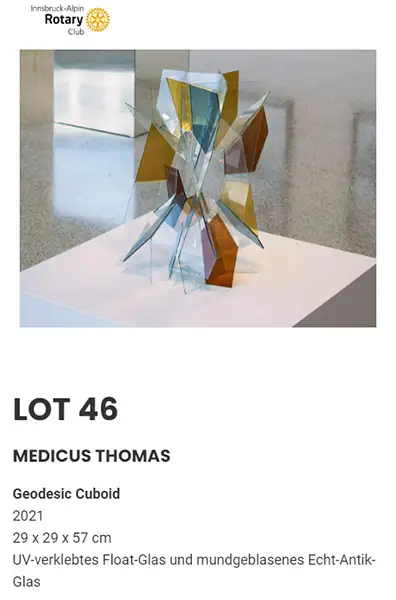

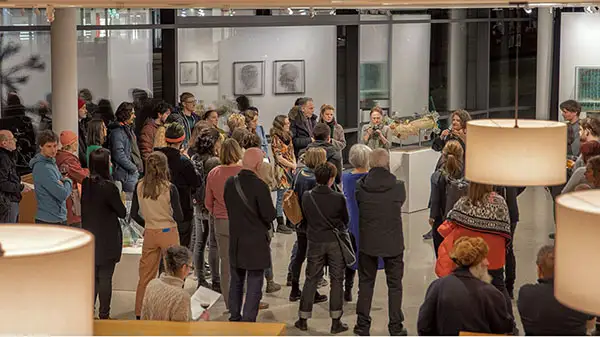
2023 EBBE, Rathausgalerie, Innsbruck

2022 Human Animal Binary, Rapoldipark, Innsbruck
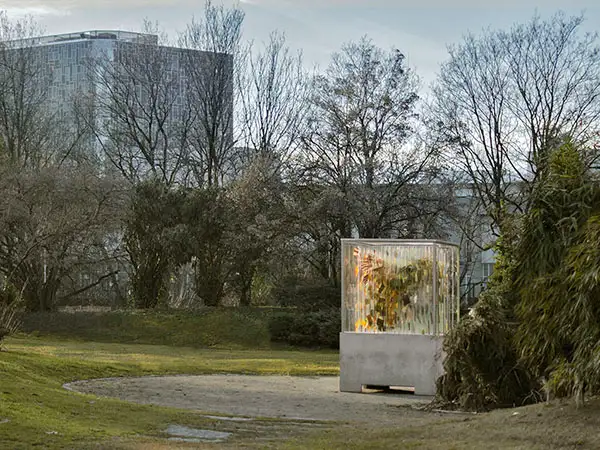
2022 Human Animal Binary, Landestheater Nebenplatz, Innsbruck

2022 EBBE, Talstation Kulturzentrum, Innsbruck

2022 EBBE, Galerie Plattform 6020, Innsbruck
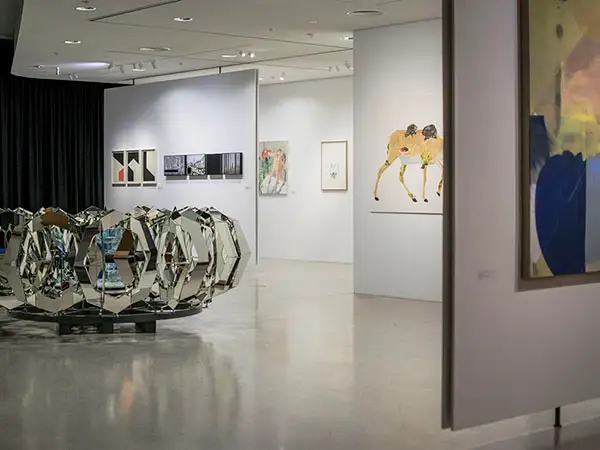
2022 EBBE, Power Plant Mühlau, Innsbruck


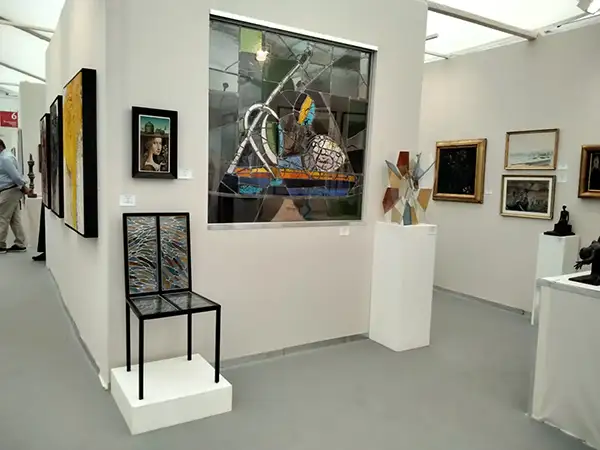

2020 Cone Eye – SOWI, Innsbruck

2020 Digital Prints – John Montagu – Innsbruck

2020 Digital Prints – Bäckerei Kulturbackstube – Innsbruck

2020 Best Before – Tivoli Kreisverkehr, Innsbruck

2019 Best Before – Waltherpark – Innsbruck
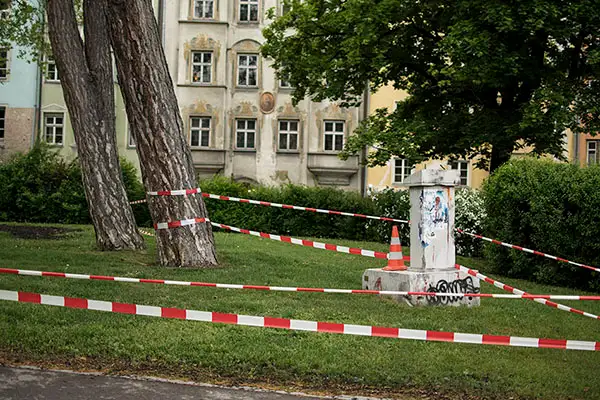
2019 Best Before – Landhausplatz and Courtyard of Altes Landhaus, Innsbruck
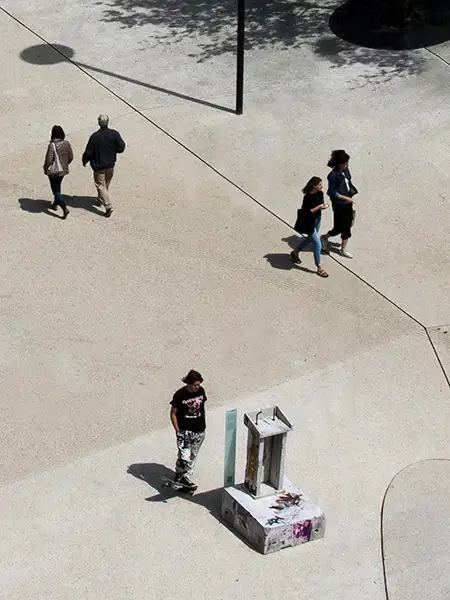


2018 Glanzstücke – Zeitgenössische Glaskunst aus Österreich – Galerie der Stadt Traun

2018 Mut-Willig – Gegen-Licht – Wildwuchs – Haus der Begegnung, Innsbruck
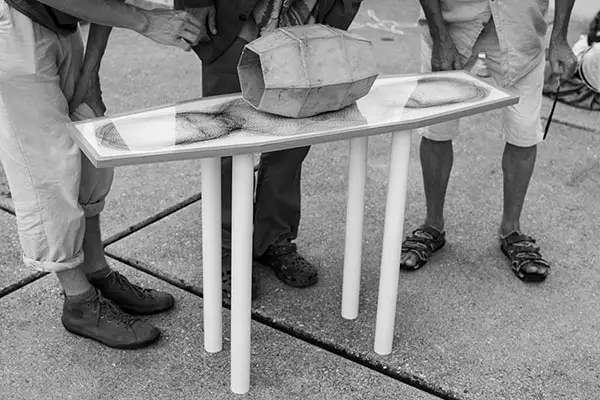
2017 Nehmen Sie Platz! – Wildwuchs – Haus der Begegnung, Innsbruck
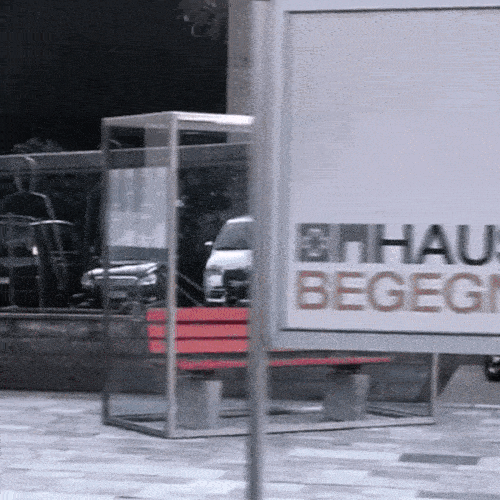
2017 404 Ort – 20 Jahre Literaturhaus am Inn – Waltherpark, Innsbruck
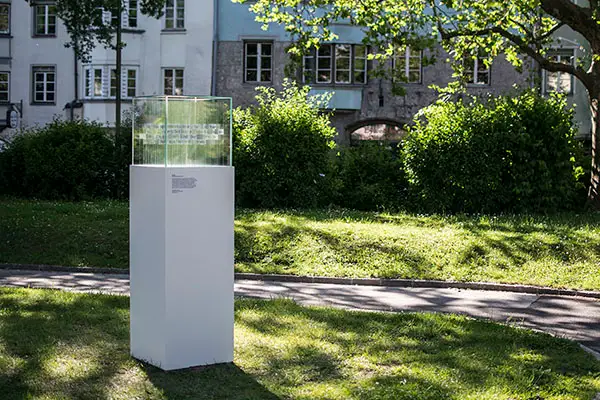
2017 Mut-Willig – Wildwuchs – Galerie Unterlechner, Schwaz
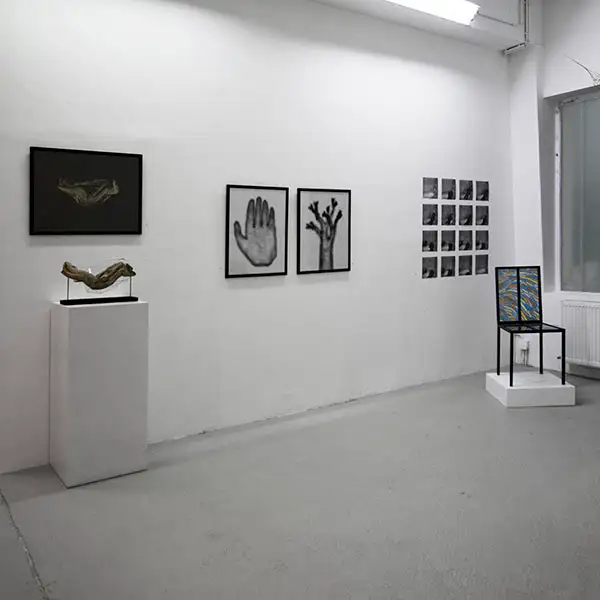
2016 Wildwuchs-Special – Infinity Black – Styleconception, Innsbruck

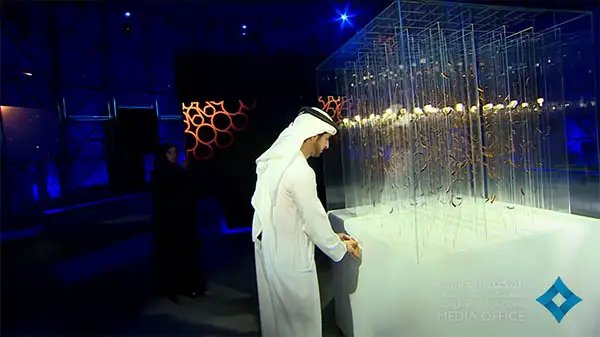
2016 Nehmen Sie Platz! – Tiroler Landestheater Vorplatz, Innsbruck
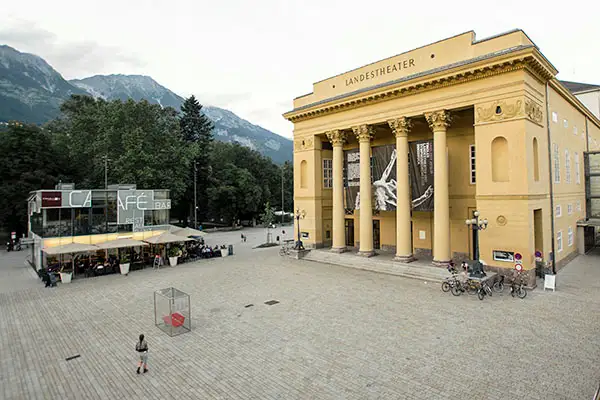
2016 Amoeba – Tiroler Glasmalerei, Innsbruck

2016 Amoeba – Bäckerei Kulturbackstube, Innsbruck
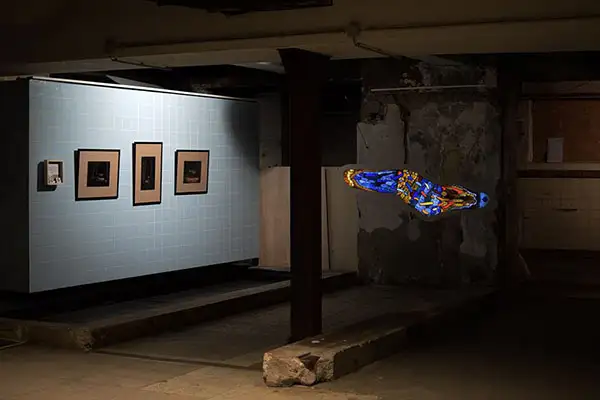
2015 Föhnfest – Bäckerei Kulturbackstube, Innsbruck

2015 Tummelplatz. Festspiel – Bäckerei Kulturbackstube, Innsbruck
2015 ART Messe – Tiroler Glasmalerei – Messehalle, Innsbruck
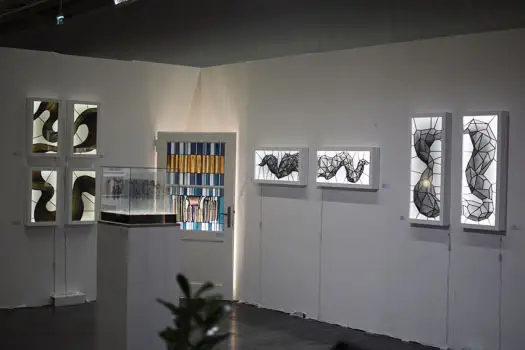
2014 Mythos Tier – Kunstverein Talstrasse e.V., Halle an der Saale
2014 Performance mit „Heads“ – Kunststraße, Imst
2014 Trans-Form – Wildwuchs – Haus der Begegnung, Innsbruck
2014 Huhn-Hut-Du – Bäckerei Kulturbackstube, Innsbruck

2013 Premierentage – Wildwuchs – HTL-Galerie, Innsbruck
2012 An- und Einsichten – HTL-Galerie, Innsbruck
2011 Babylon, Vertikale Positionen – Wildwuchs – Münzerturm, Hall in Tirol
2011 Einzelausstellung – Integrationsbogen, Innsbruck
2010 Kunstsymposium – Wildwuchs – St. Magdalena, Halltal
(…)
Public Purchases and Fundings
2024 Kunst im öffentlichen Raum Tirol (KÖR), We Are the Asteroid

2022 Ankäufe der Stadt Innsbruck, EBBE
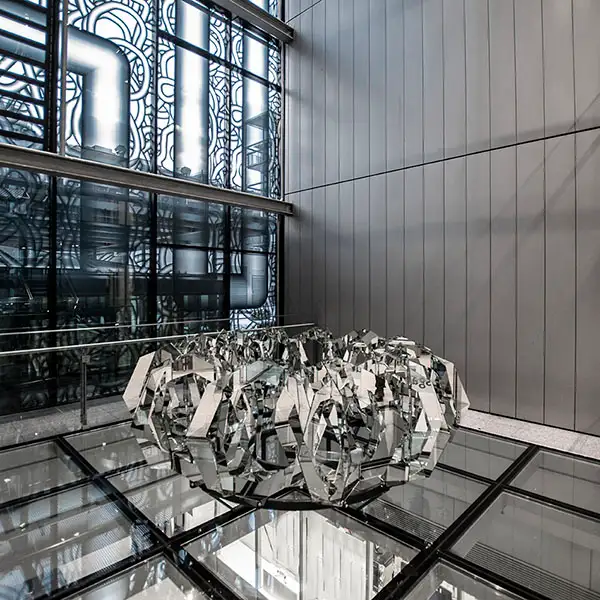
2022 Tiroler Kultur Initiativen (TKI), EBBE

2021 Tiroler Kultur Initiativen (TKI), Human Animal Binary

2021 Ankäufe des Landes Tirol, Holes Staircase
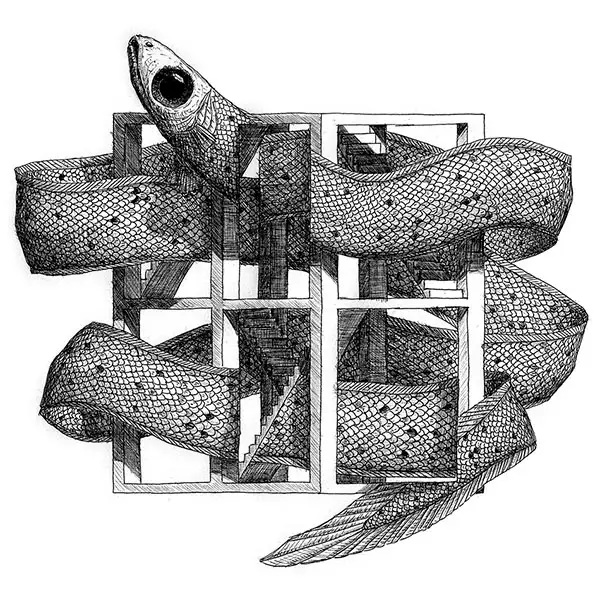
2019 Tiroler Kultur Initiativen (TKI), Best Before
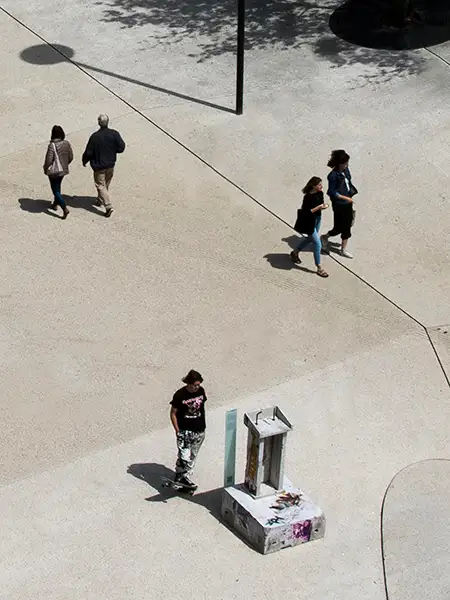
2017 FACTS Boredeaux, LudoModuL
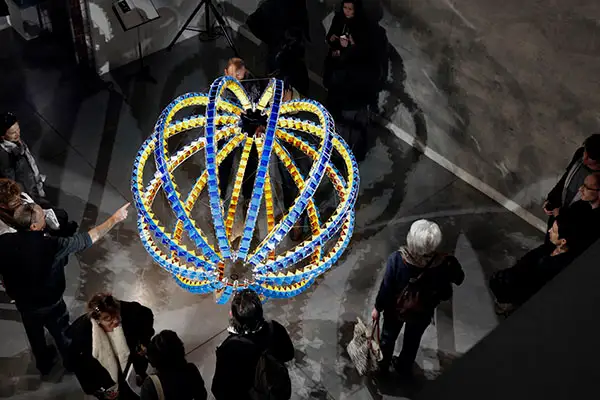
2017 20 Jahre Literaturhaus am Inn, 404 Ort (with Martin Fritz)
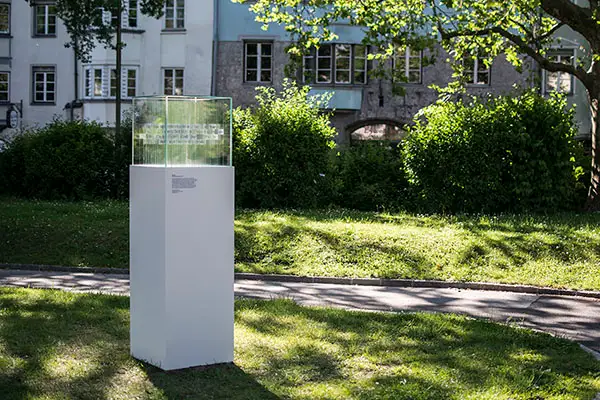
2016 Kunst im öffentlichen Raum (KÖR) Tirol, Nehmen Sie Platz

Interviews
Reception
in publications
2024 Kunstankäufe Land Tirol 2019–2023 | Land Tirol, Abteilung Kultur | INVENTUR, Band 2 | Thomas Juen (Hrgs.) SIMB Verlag.
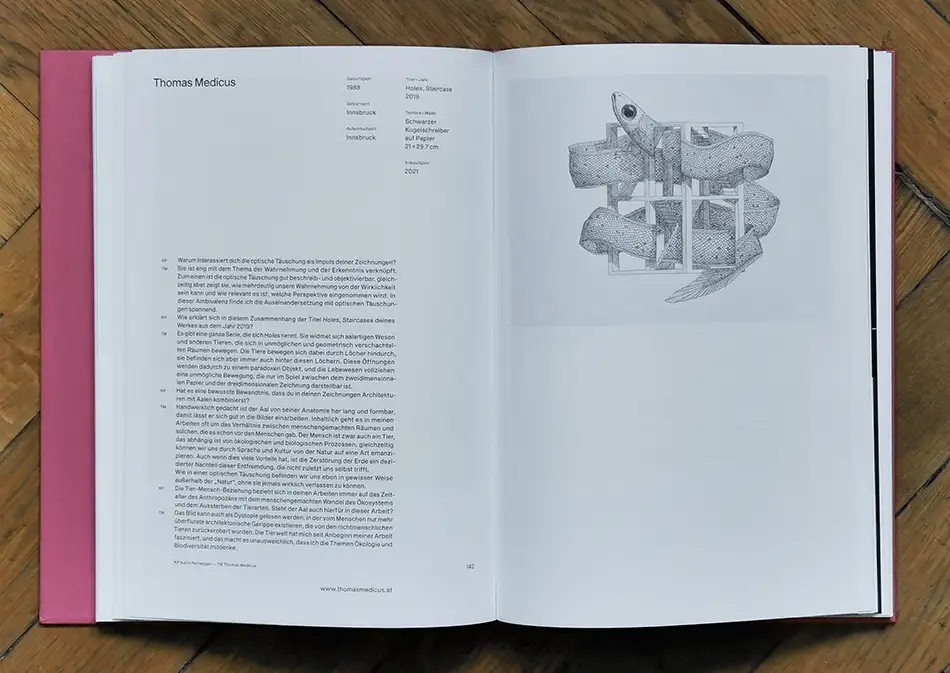
2022 International Floral Art 2021-2022 (ISBN: 9789058566584)

2021 Netzwerk neu B1.2 (ISBN: 9783126071710)

2020The Art of Optical Illusion (ISBN: 9789401461535)

2018 Ripley’s Odd Is Art (ISBN: 9781784759698)
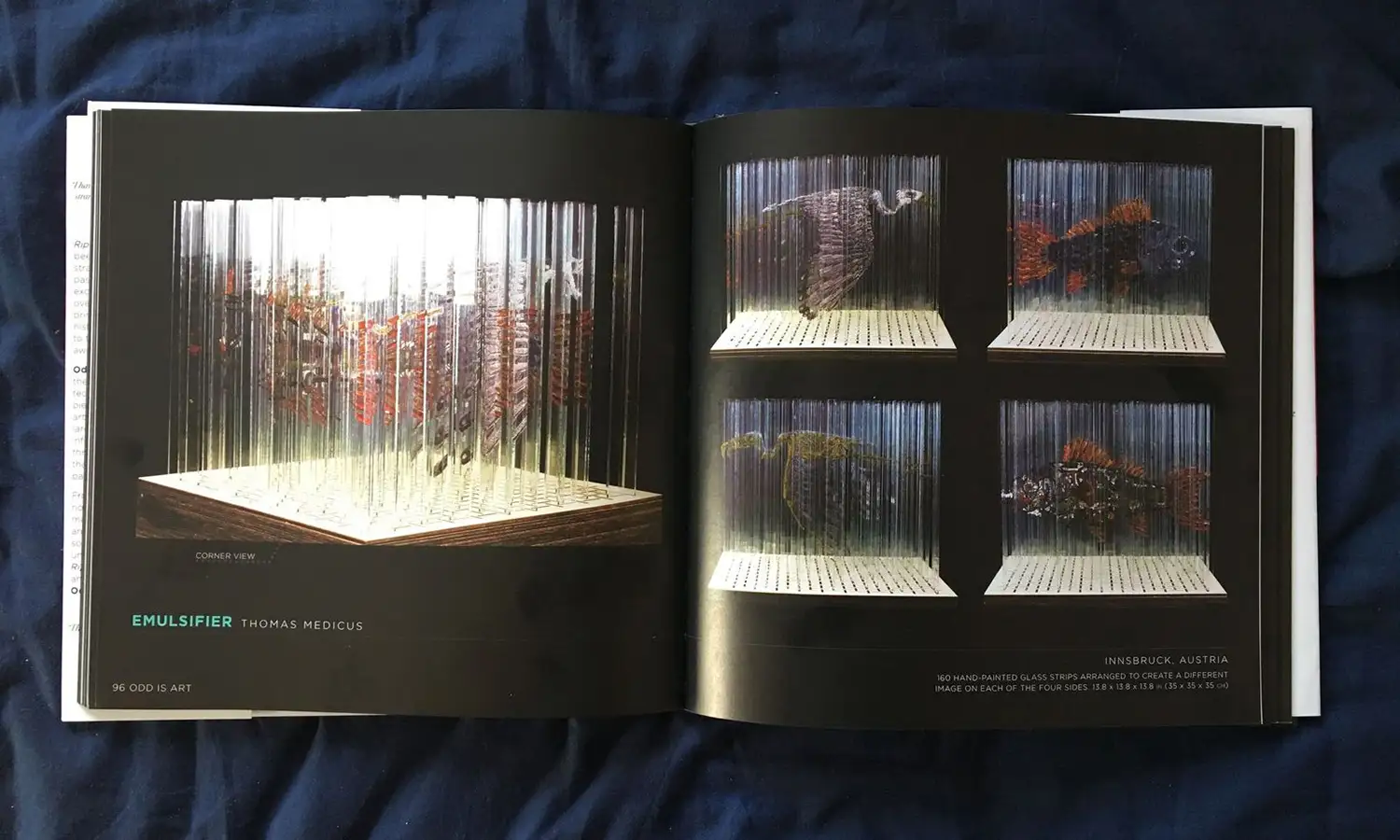
in scientific contexts
2023 Nilay Er, Ergün Arda - Stained Glass Sculpture: Marine Bio Diversity (Journal of Current Researches)2020 Taís González - Understanding women’s stewardship in the Amazon (master thesis)
2020 Brigitte Anna Egger - Bänke lesen (master thesis)
in broadcasts
in magazines and newspapers
on websites and social media
2025 Mein Bezirk2024 Arts Help
2024 گالری آنلاین Online Art Gallery
2024 stupidDOPE
2024 ORF Tirol
2024 Designboom
2024 Molten Immersive Art
2024 Handwerk+Bau
2023 This Is Colossal
2023 30 Millions d’Amis
2022 Molten Immersive Art
2022 Designboom
2021 Daily Nous
2020 This Is Colossal
2020 Fix Media
2020 Hi-Fructose
2019 This Is Colossal
2019 Art Insider
2018 Bigumigu
2018 Un Poco De Todo
2017 Designboom
2017 Bigumigu
2016 Booooooom
2016 Designboom
2016 Fubiz
2016 Laughing Squid
2016 The Creators Project
2016 Trendland
2016 Design You Trust
2016 Gulf News
2015 Fubiz
2015 This Is Colossal
2015 Booooooom
2015 Bigumigu
2015 Bigumigu
2015 La boite verte
2015 My Modern Met
2015 Laughing Squid
2015 Artribune
2015 Kraftfuttermischwerk
2015 Hypebeast
2014 This Is Colossal
2014 Laughing Squid
2014 Ignant
2014 Audubon
2014 Page
2014 Mega Curioso
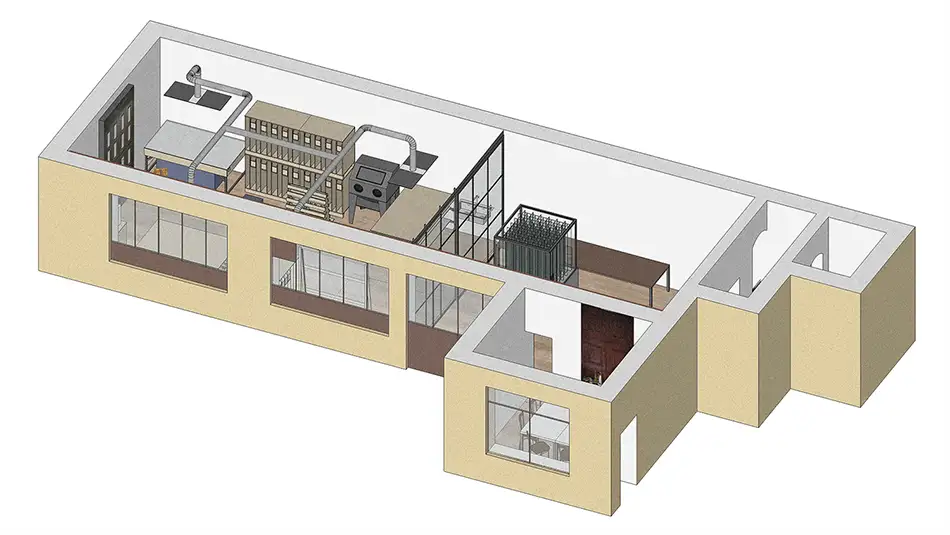
STUDIO MEDICUS
Workshop for stained glass, conservation and cultural projectsDreiheiligenstraße 19, Stöcklgebäude
AT-6020 Innsbruck
VAT-ID: ATU74670545
Google Maps • Site plan for truck delivery

NEWSLETTER privacy policy
CONTACT
PHONE
+43-(0)650-3384586
Instagram
•
Facebook
•
LinkedIn

2024 - We Are the Asteroid
WE ARE THE ASTEROID
The basis of We Are the Asteroid is an analogy between the activities of humans on Earth and an asteroid impact 66 million years ago. Along with other species, this led to the disappearance of the dinosaurs and thus to the fifth mass extinction.
Humans have been responsible for the extinction of animal species for thousands of years. Today, a massive acceleration of this destructive process can be observed and the threat of the sixth mass extinction looms. [1]
The decline of wild animals caused by humans contrasts with an unimaginable number of industrially farmed animals. Two areas that are closely linked:
The expansion of agricultural land is one of the main drivers of the biodiversity crisis globally. [2] Grazing land and the cultivation of animal feed account for the majority of these areas. [3]
As meat and milk production are very inefficient compared to plant-based food production, an end to animal livestock farming would free up three quarters of all agricultural land as potential habitats for wildlife. [4]
We Are the Asteroid denounces this double lack of solidarity between humans and non-human animals. The artistic intervention encourages us to question the future viability of industrial livestock farming and to think about restoring the land that can be reclaimed from it.
[1] ROBERT COWIE ET AL. (2022) THE SIXTH MASS EXTINCTION
[2] WWF - LIVING PLANET REPORT (2022) BUILDING A NATUREPOSITIVE SOCIETY
[3] SKIDMORE ET AL. (2021) CATTLE RANCHERS AND DEFORESTATION IN THE BRAZILIAN AMAZON
[4] HANNAH RITCHIE (2021) IF THE WORLD ADOPTED A PLANT-BASED DIET
DISTRIBUTION OF THE BIOMASS OF ALL MAMMALS
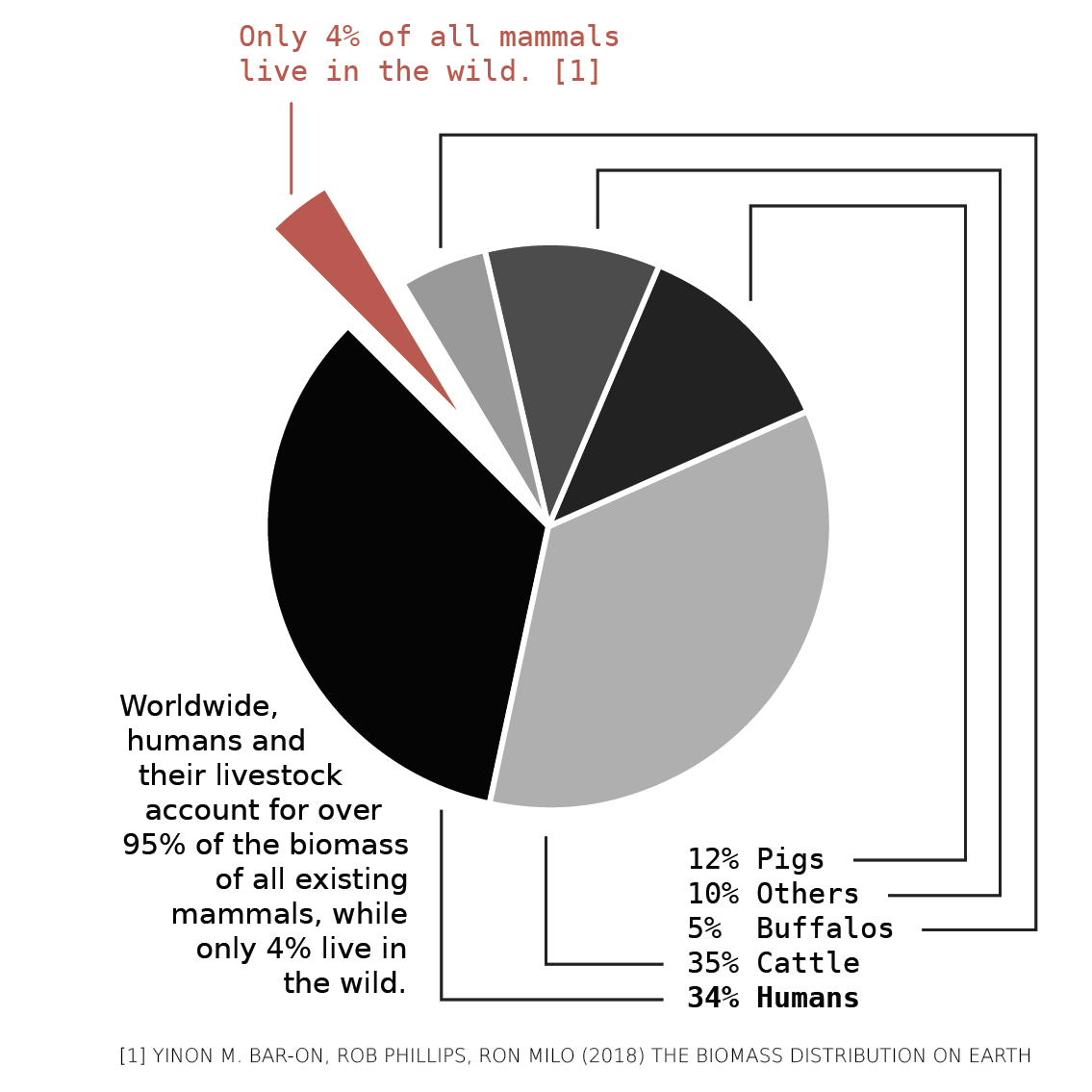
THE SIXTH MASS EXTINCTION
The extinction of animal species is part of evolution and is called the background extinction rate. However, the current impact of humans is likely to increase this rate by a factor of 100 to 1000. [1]
Due to a lack of data, it is very difficult to make more precise statements. Therefore, more research is needed.
It is estimated that around one million species could become extinct in the next two decades. This would equate to 150 animal and plant species per day. [2]
Rainforests are mainly affected, as they are being cleared to make way mostly for agricultural land for animal feed production and for grazing land for cattle breeding. [3] Both animal feed and beef are imported to us on a large scale. [4]
In Austria, a large number of species are also endangered or already extinct. For example, it is unimaginable today that commercial fishing in the Inn was important until the 19th century [5] and ultimately stopped with the building of hydroelectric power plants. [6]
[1] ROBERT COWIE ET AL. (2022) THE SIXTH MASS EXTINCTION
[2] IPBES (2019) GLOBAL ASSESSMENT REPORT ON BIODIVERSITY AND ECOSYSTEM SERVICES
[3] SKIDMORE ET AL. (2021) CATTLE RANCHERS AND DEFORESTATION IN THE BRAZILIAN AMAZON
[4] HEINRICH-BÖLL-STIFTUNG, GLOBAL 2000, VIER PFOTEN (2021) FLEISCHATLAS
[5] PAUL EUGEN GRIMM: INN. IN: HISTORISCHES LEXIKON DER SCHWEIZ
[6] EBERHARD PFEUFFER (2014) BIODIVERSITÄTSVERLUST DURCH FLUSSVERBAUUNG
AREA REQUIREMENT FOR ANIMAL AND PLANT CALORIES
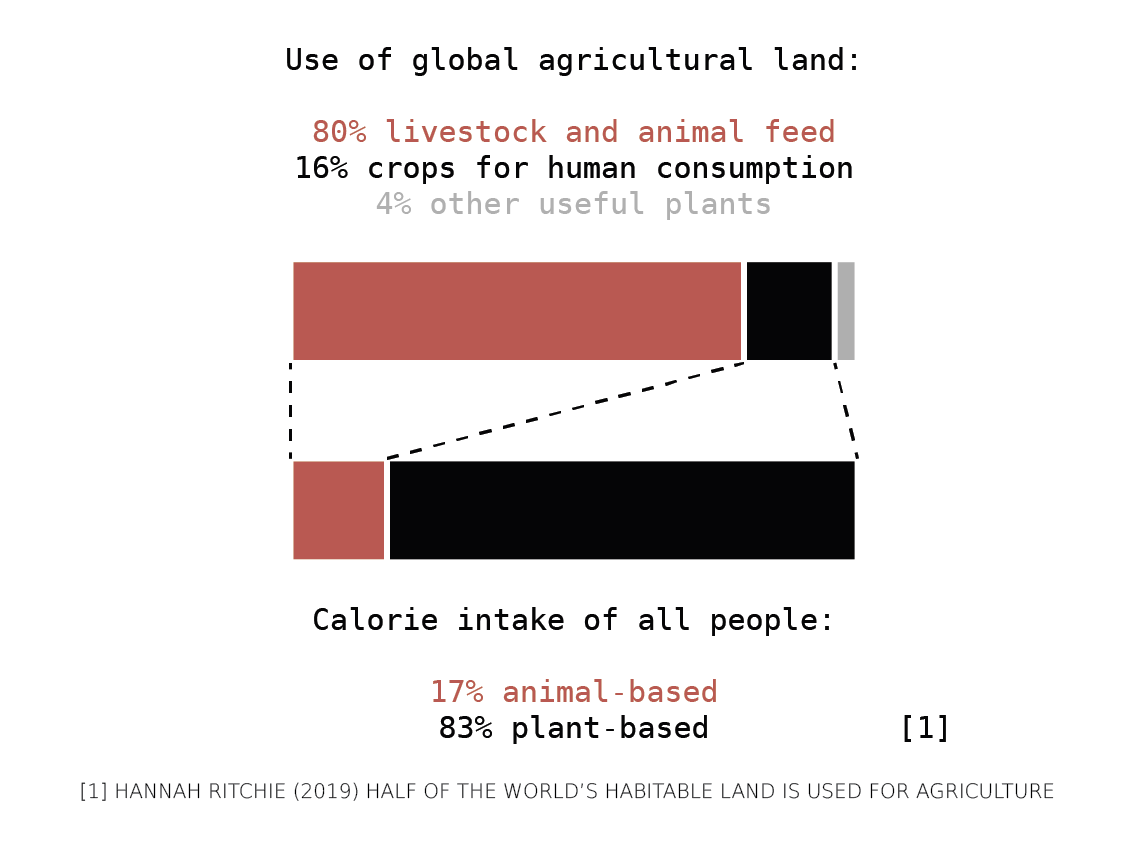
Agricultural land is mainly used for livestock farming, but this only provides a small proportion of total calories.
Plants, on the other hand, play only a minor role in total land consumption, but provide the majority of calories in the human diet.
One calorie of beef requires 100 times as much land to produce as one calorie of tofu. [2]
[2] HANNAH RITCHIE (2022) ENVIRONMENTAL IMPACTS OF FOOD PRODUCTION
CAUSES AND SOLUTIONS
Austria and Europe have shown in the past that wildlife conservation can be successful. The relocation of agricultural land to the Global South since the 1950s [1] and the expansion of nature reserves [2] have enabled many species to recover. [3]
These successes show that improvement is possible and that intact habitats are needed for biodiversity.
However, this should not obscure existing deficits. Our rivers in particular are not ecologically intact over long stretches due to heavy construction for regulation and hydropower generation. [4]
In addition, climate change and the use of pesticides [5] are putting many species under pressure. In the Alps, this threatens to lead to increased extinction, as species migration is difficult due to the highly fragmented landscape. [6]
In addition to the restoration of lost habitats, we are also called upon to monitor supply chains more closely: By importing meat and feed for our industrially farmed animals, we run the risk of contributing to the sixth mass extinction in the history of the planet.
[1] WORLD BANK GROUP - DATA - AGRICULTURAL LAND (% OF LAND AREA) - AUSTRIA
[2] OUR WORLD DATA (2021) SHARE OF LAND DEFINED AS NATURAL HABITAT
[3] LEDGER ET AL. (2022) WILDLIFE COMEBACK IN EUROPE: OPPORTUNITIES AND CHALLENGES
[4] SCHMUTZ ET AL. (2010) ÖKOLOGISCHER ZUSTAND DER FLIESSGEWÄSSER ÖSTERREICHS
[5] HEINRICH-BÖLL-STIFTUNG, GLOBAL 2000 (2022) PESTIZIDATLAS
[6] THUILLER ET AL. (2005) CLIMATE CHANGE THREATS TO PLANT DIVERSITY IN EUROPE
Go to We Are the Asteroid project entry.
alena-klinger.webp)
2023 - Ecotopia
Ecotopia is an installation that focuses on our understanding of "nature" as "the other" but also as something within us. The installation creates a paradox: artificial, human-made space and natural space independent of humans are both separated from and merge into one another. As when looking at the installation, we find ourselves outside of nature without ever really being able to leave it; we are part of the world from which we have sprung.
Ecotopia thus condenses something that is inherent in every representation of nature: only alienation from nature enables an art that makes nature the object of its representation. Like the science of nature, the art of nature is in a position to oppose the strangeness of nature, but this power over nature is only available at the price of alienation from it. Our view of ‘nature’ irreversibly presupposes an immanent contradiction.
Go to Ecotopia project entry.
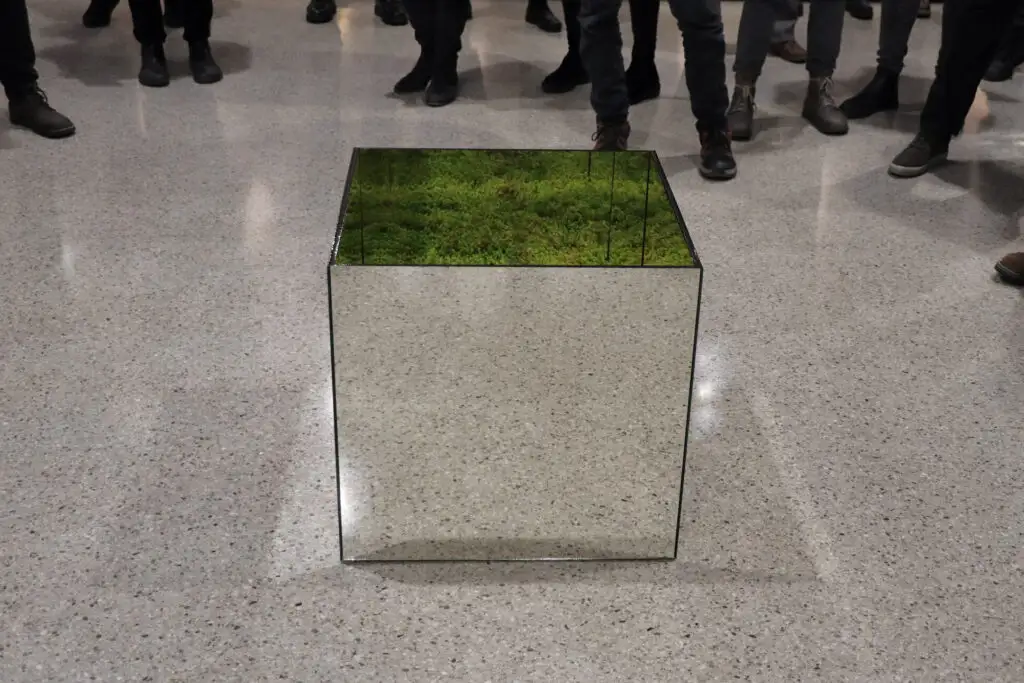
2023 - Decoder
In the linguistic approach of performativity, language is not just a tool for describing the world that is either used correctly or incorrectly. It inevitably creates reality; it is always communication that forms the subject of a society. How does the serial code, the code that is language, influences the way we access our world?
Decoder is a work that deals with the decoding and categorisation of a description-independent outside world, but in the other direction also with the linguistic programming of an inside world - which for its part produces an outside. How absolutely can these two external worlds be distinguished from each other?
The object of cognition in this arrangement is a piece of driftwood cast in concrete, a hybrid body reminiscent of both a faded tree trunk and a fragment of a demolished building. So what defines this object, its tree-like, once living surface or its artificial, concreted interior?
Go to Decoder project entry.

2023 - Below The Surface Is Another Surface
Whoever removes one surface encounters the next. The installation Below The Surface Is Another Surface deals with questions of staging and cognition. Is there an interior behind the artificial facade or do we only look at the next surface there? Is there something hidden behind the art or is it what it is? Does cognition ultimately remain the perpetual removal of the ever-next layer?
The American philosopher Thomas Nagel states in this regard that our subjective experience, that is, the experience of what it is like to be, can ultimately only be experienced. Since scientific knowledge by definition must take an external perspective, its description of this quality of consciousness, which shapes our entire reality, would miss the point.
"Below the Surface Is Another Surface" revolves around these themes: The experimental sculpture shows sectional planes of a head and a discreetly recognizable star-shaped body. The installation, reminiscent of MRI scans, is meant to make visible that there are different ways to look inside a person, different perspectives that come to different conclusions. On the one hand, we can gain impressive insights into the inside of a human being through examinations and measurements, on the other hand, the experience of what it is like to be that human being remains closed to these methods.
Go to Below The Surface Is Another Surface project entry.
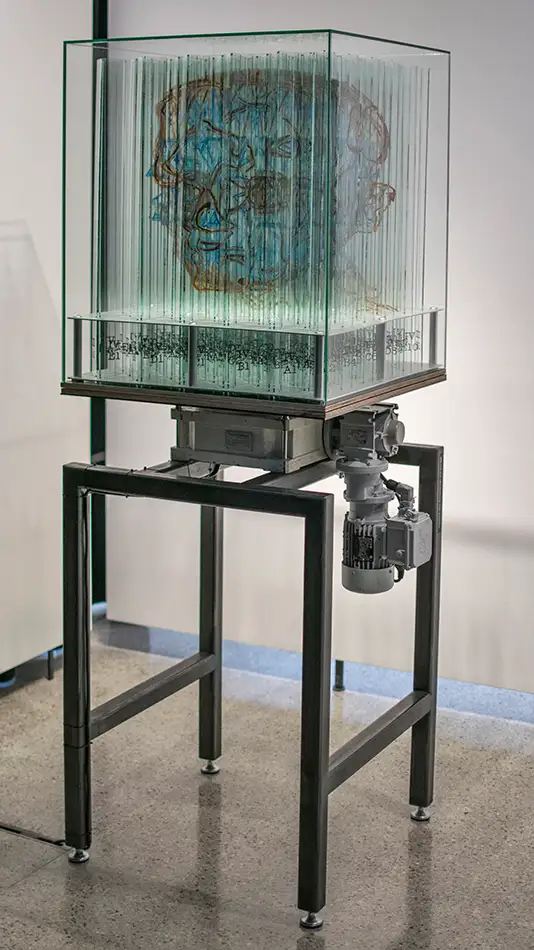
2022 - Human Animal Binary (project description)
The discourse on climate change is not new; it has been the subject of scientific and political debate for decades. In recent history, the debate about humans' problematic interventions in nature has gained urgency and publicity, and has achieved considerable success. Nevertheless, it has not yet been able to cause a turnaround.
The Anthropocene era has long since dawned; harmful human influences can be detected across the globe. But the climate crisis not only threatens dramatic ecological upheavals, it is also accompanied by the intensification of social conflicts.
What can be the symbolic and discursive contribution of art in view of the extent of this threat? Social processes are always criticized, commented on, or at least represented by art. In a sense, it is an outpouring of its own historical context; neither aspect can be fully read without the other.
The anamorphic sculpture with four richly detailed images of bee, lynx, kingfisher, and river trout is initially a low-threshold intervention with a strong experiential dimension. An optical trick creates a synchronicity of image and object: the animal representations are interlocked according to a certain system over 144 glass strips in a cube-shaped space. As a result, the two-dimensional representations disintegrate into a cloud-like complex of image fragments as they circumnavigate the sculpture and reassemble themselves - like a constant emergence and decay of living creatures.
Thomas Medicus has already used the functional principle of the installation in various contexts. Coupled with the idiosyncratic animal representations, this illusionary technique fulfills an affirmative task in Human Animal Binary. It conveys the incomprehensibility of life, even when this threatens to disintegrate in the next moment. The brutality of environmental destruction becomes clear in contrast to the overwhelming diversity and independent vitality of nature.
This artistic treatment is accompanied by a text on the biodiversity crisis per picture and page. Starting from the respective depiction, an arc is drawn to larger ecological contexts; the linking of locally particular phenomena and globally universal processes is expressed therein.
Human Animal Binary is in many respects a sculpture that links dichotomies and in this way creates that "in-between" that locates a work of art in a discursive space.
The title Human Animal Binary, as well as the use of the industrial materials concrete, glass, and metal, allude to a dilemma in which much of humanity finds itself: Human habitat largely contradicts coexistence with non-human animals. In order not to exceed the capacity limits of the planet and thus prevent the destruction of our habitat, a fundamental show of force on a global scale is needed.
The human living, production and activity space expanded to large areas of the planet is based on the plundering of "nature". It affects - not least - ourselves, who as highly developed living beings are part of nature and completely dependent on the success of biological and ecological processes.
The climate crisis and the pandemic make it clear once again that our understanding of "nature" as something different, something subordinate to us, has begun to crumble and that the renewal of the foundations of civilization has long since become necessary.
Yet artistic intervention is unable to resolve this dilemma; the representations of nature remain trapped under the glass cover.
The construction of Human Animal Binary caused about one ton of CO2, which takes a mature spruce fifty years to bind. A maximum of two tons of the greenhouse gas may be emitted per capita and year for the human species to become climate-neutral. This limit is currently exceeded many times over in industrialized countries.
Would it have been better not to produce Human Animal Binary at all because of this incorporated contradiction?
The countless image fragments of the object were made with the help of the stained-glass technique that has existed since the Middle Ages: Colors are burned into the surface of the glass and can last for many centuries, despite the fragility of their support material.
One day the installation will stand in a different social context: as a memorial that has come true or as a relic of a time that has been overcome.
Go to Human Animal Binary project entry.
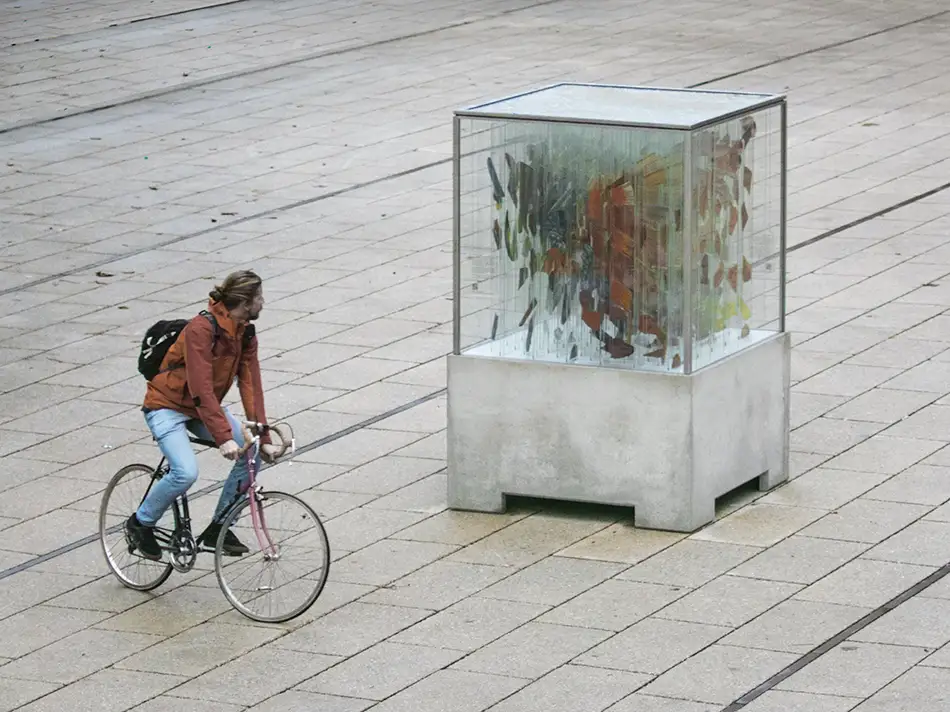
2022 - Human Animal Binary (four animals)
Bee
The contribution of honeybees to the agricultural economy and the survival of countless plant species is enormous. Due to pests, diseases, pesticides and air pollution, many bee colonies are dying in different regions of the world. A complete disappearance of the honey bee would have devastating consequences for our entire ecosystem.
In Tyrol, the endangerment of various species of wild bees is particularly noteworthy. Due to their specialization on certain plant species, these bees play an important role in maintaining biodiversity in meadows. However, overfertilization has already greatly reduced plant diversity and thus deprived wild bees and many other insects of food sources.
Lynx
Lynx were common almost throughout Europe. However, they have largely disappeared since the 20th century. Instead of making ecological sense the focus of hunting, they were often shot simply for their fur. In addition, the animal posed a problem in livestock farming.
Since the shy and largest wildcat species in Austria does not migrate much, its reintroduction is proceeding very slowly and is further hampered by illegal killing.
Worldwide, humans with their farm animals account for over 90% of the biomass of all existing mammals. Only a small minority - like the lynx - lives in the wild.
River Trout
Many fish populations in our waters are increasingly being deprived of their habitats. Hydroelectric power plants, river engineering and water warming are accelerating the drastic decline in populations. The river trout, which is highly endangered in our country, is also affected.
Internationally, overfishing of the oceans is a particularly explosive environmental issue. Alongside human-induced pollution, it is one of the main reasons for the extinction of countless fish species. In many places, overfishing also causes social upheaval: Fishing companies are depriving themselves of their own livelihoods through unsustainable and profit-driven practices.
King Fisher
The displacement of non-human species can only be understood in a larger ecological context. Because the native kingfisher lives along flowing waters and feeds primarily on fish and insects, it is directly affected by declining fish populations and insect mortality.
Like many of its congeners, it is in particular distress because of the destruction of its habitat: almost all rivers and streams in Europe have been obstructed or regulated, and ponds and wetlands drained.
Human intervention in nature has led to a global decline of more than 60% in wildlife over the last 50 years.
Go to Human Animal Binary project entry.
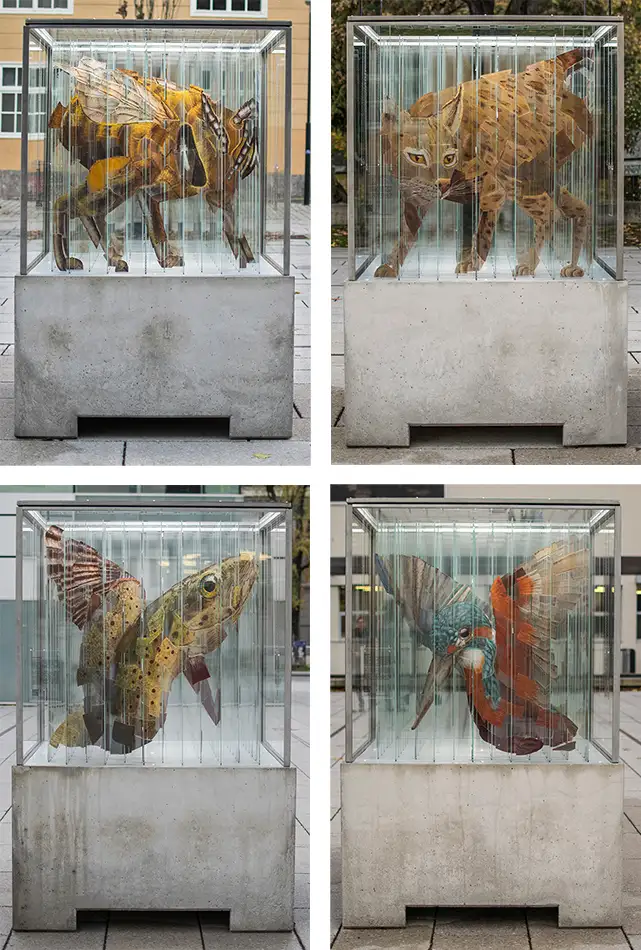
2022 - EBBE
EBBE [German for ebb tide] is a formerly site-specific installation for a decommissioned hydroelectric power plant in Innsbruck. The project aimed to make energy production visible and thus raise awareness of issues such as energy scarcity and water ecology.
As a largely CO²-neutral form of energy production with good possibilities for energy storage, hydropower is an indispensable energy source in times of climate change. Nevertheless, hydropower is criticised primarily because of its serious impact on the ecology of a landscape. The regulation of rivers and their construction with power plants has caused great damage to the biodiversity of water bodies.
The power plant with its impressive turbine hall is a listed building. Since this space was to be made accessible to the public, it was important to develop a project that would emphasize the historical dimension of the building and at the same time have a strong independent quality.
The majority of the turbine-shaped installation consists of mirrors, which serve two purposes:
Mirrors do not have an independent surface, but take on the appearance of their surroundings. Thus, the material contributes to the site-specific character of the installation.
At night, moreover, the mirrors distribute water-like reflections throughout the hall. The vivid light is created by a rotating geometric glass element made of float glass and blue hand-blown glass, which hangs in the center of the installation and is illuminated by six LED bars.
The palindrome EBBE as the title of the installation not only transports the reflective character of the artwork. For as is well known, after the ebb comes the flood: the installation makes use of this dichotomy and transforms the stagnant hydroelectric power plant into a dynamic place for art and culture.
Go to EBBE project entry.

2021 - Optometrist
The eye as a boundary layer between the outer, surrounding world and the inner, perceived world has always created space for reflection. It is a allegory of that self-referentiality from which we can never really squirm out: All knowledge must always be perceived and interpreted in one way or another. Even if there are many indications that large areas of our reality can be described, the description always differs from the thing itself. This applies in particular to our perception: how it is to experience is reserved for the experience. It can also be described, but that is then again the description of something and not the thing itself. Perhaps art will succeed in making this subjective experience tangible for others, i.e. making it intersubjective.
The digital illustration is a commissioned work for the 150 years anniversary of Miller Optics.
Go to Optometrist project entry.

2020 - Cone Eye II
The anamorphic sculpture shows a black and white photograph of an eye placed on the inner surface of a cone. Based on the piece Cone Eye I from 2019, it was reproduced on a larger scale to be hung in the glass superstructure of an underground car park entrance. The object is thus placed in a dry, illuminated and accessible display case in the centre of Innsbruck without occupying urban space used for other purposes.
However, Cone Eye is not primarily intended to raise questions about the use of public space. In a way, the installation reverses the process of viewing: The gaze is thrown back at the person looking; at this moment, they themselves become part of the installation. In this way, Cone Eye condenses something that is inherent in every artistic work: to a certain extent, art only becomes complete when it is perceived and thought. The work of art is thus inextricably intertwined with its counterpart; it is essentially relational.
Go to Cone Eye II project entry.
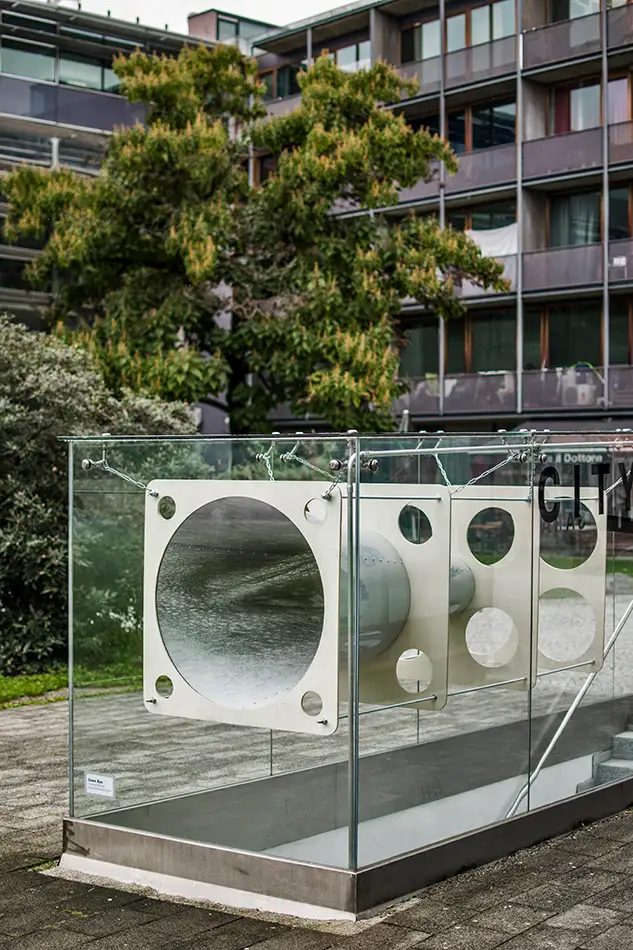
2020 - What It Is Like to Be
What It Is Like to Be is an anamorphic sculpture made of 144 hand-painted glass strips. The cube-shaped object shows four fragmented images that reassemble with every 90° rotation. The glass strips are cast in a concrete base, which sits in a wooden bowl and is around 30 centimetres long. All fragments were individually painted onto the strips with acrylic paint.
The title is inspired by the essay "What Is It Like to Be a Bat?" by the American philosopher Thomas Nagel. In it, Nagel states that our subjective experience, in other words the experience of what it is like to be, can ultimately only be experienced. Since scientific knowledge must by definition take an external perspective, its description of this quality of consciousness, which characterises our entire reality, would miss the point.
Go to What It Is Like to Be project entry.
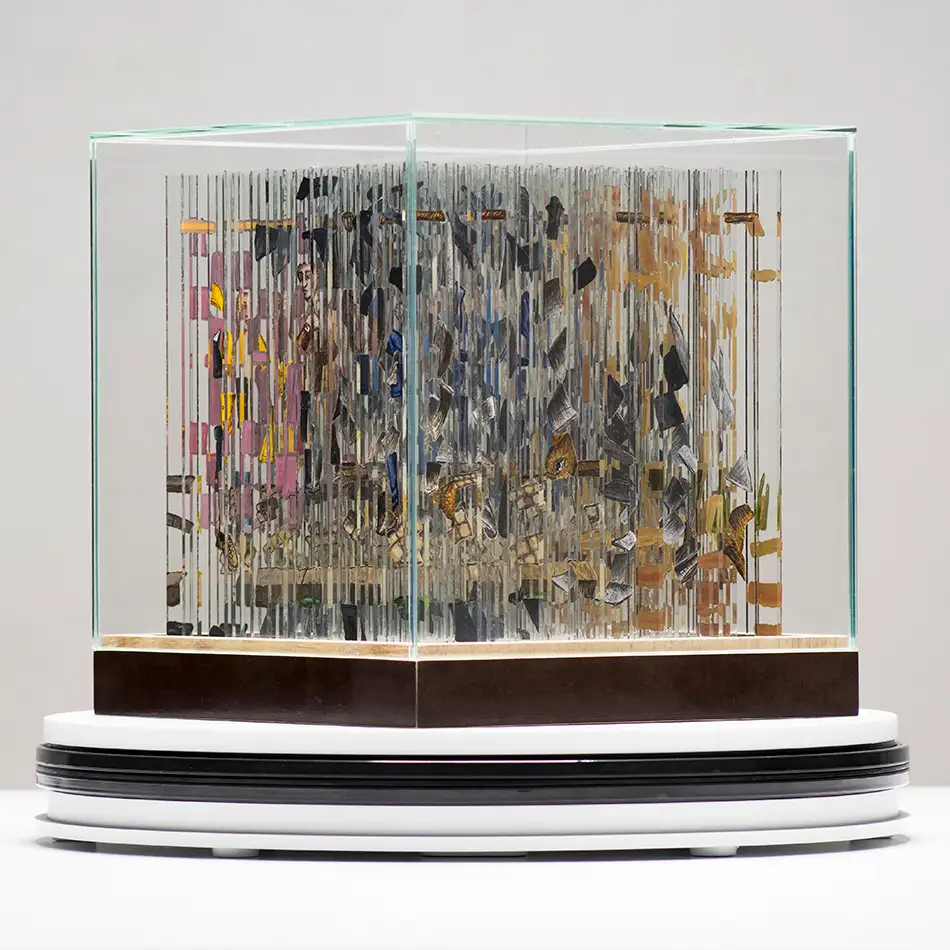
2019 - Best Before
An Artwork Answers Itself [Text for UND-Heft #7]
Originally, the dilapidated concrete lectern Best Before was intended as a dystopian fictional relic from a comprehensively de-democratized society, as a critical commentary on the relationship between the economy and the state, and as an interactive installation. Interactive because by entering it, a playful role reversal can take place from democratic sovereign to representative of that very sovereign.
More simply, the sculpture was meant to invite general reflection on democracy and the state of that very democracy. The art installation was intended to make political speech what it is in essence, namely a public matter, and thus to show that democracy can only exist at all in a constant process of negotiating itself out of existence. But it turned out differently - and yet not.
The project was submitted in 2019 to the project funding track TKI open, which is announced annually and is endowed with funds from the province of Tyrol. For this purpose, TKI - Tiroler Kulturinitiativen puts together a jury of experts who discuss all project submissions in a public jury meeting. The results of this transparent and content-focused process are then proposed for funding to the state's cultural department, where a final review of the submissions is conducted and the final decision is made.
Best Before was selected by the TKI jury, approved by the Provincial Councillor for Culture and funded by the Province of Tyrol.
The site-specific intervention was conceived for Innsbruck's Landhausplatz, which is obvious and makes sense due to the political relevance of the square and its proximity to the Landhaus. This was also described in the project submission.
In order to coordinate the many processes in the public space, it must be managed. This also applies to the Landhausplatz. The real estate administration - a department of the province of Tyrol - is responsible for handling all processes on the square. With the intention of finding a suitable period for the installation of Best Before, a corresponding request was submitted to the property administration. This was rejected because of the alleged "endangered traffic safety" caused by the project. This is a surprising reason, since the square is very large and the sculpture occupies an area of one square meter. The installation of a project financed from the cultural budget of the province of Tyrol was therefore not permitted by the same, namely the province of Tyrol.
In countless subsequent conversations with various people from the legal department, property administration and culture department, many reasons were given for a cancellation, none of which could be explained conclusively. It was made clear that the space was taboo for art and that the sculpture had no place on Landhausplatz.
After laborious negotiations, three weeks were verbally promised for the installation of the sculpture at Landhausplatz, which finally became three days at the back of the square.
However, the property management offered to place the object in front of St. George's Chapel for one month, i.e. in the semi-public courtyard of the Landhaus. The sculpture had thus found its way into the political heart of the state directly in front of the Tyrolean parliament, but there it was - swallowed by the Landhaus, as it were - in a place largely hidden from the public.
Fortunately, Best Before found other installation sites not administered by the state, such as the square next to the Landesmuseum and the Waltherpark.
In addition, the story about the permit was picked up by both the Tiroler Tageszeitung and the Stadtblatt. In this way, this example of non-transparent administrative procedures was heard by the public, and an interest in administrative transparency that went beyond the project became apparent.
In a way, the approval processes of Best Before made visible what the project originally asked for: democracy crumbles when the debate about it does not take place publicly, when non-transparent processes exclude the population or parts of it, when the implementation of decisions that are transparent in terms of democratic policy is hindered and made impossible by the administration.
A step that would express political will would be an open discussion process with the goal of creating transparent conditions for art projects at Landhausplatz.
Go to Best Before project entry.

2017 - 404 Ort
Text blocks by Martin Fritz
looks to EAST
Laut Amt dreihundersechzig Grad
ohne Markt der Hallenwürfel dort
Brenner liegt zwei Zeilen weiter
Faksimiles auch hier gegen Geist
looks to SOUTH
raus Berg hinter Stift und Stufe
einträchtig arbeiten die Rotoren
mein Fleiß im Plural keine Tanne
draußen horten sie sowie wurzelt
looks to WEST
spiegelt das was heute schwefeln
per Santers Haus zwischen Emojis
alle zu Ende der liegt gegenüber
nur die Flieger schweigen golden
looks to NORTH
nur mehr Regalen verunsichtbaren
unbedingt Bilder nicht berührend
nicht Licht nicht Archiv bis ich
ganze Kategorien ablöse beim Use
Project description
The anamorphic sculpture was created in collaboration with the author, literary scholar and theatre maker Martin Fritz to mark the 20th anniversary of the Literaturhaus am Inn. It is inspired by the view towards the four cardinal points from Literaturhaus am Inn. The resulting texts are applied as fragments to 144 glass strips and distributed in space in such a way that they constantly dissolve and reassemble as you walk around the installation.
By transferring the sculpture that is originally linked to one specific surrounding to another place, a paradox is created that is simulated though the seemingly evanescent character of the sculpture. Since the site-specific texts were written from the Literaturhaus, looking in all four directions, they define an exact point - namely the Literaturhaus. The anamorphic cube, determined by constant self-dissolution, embodies the impossibility of shifting one coordinate without it becoming another.
The title 404 Ort (Ger. for "place") refers on the one hand to the four four-line text blocks and their (in)visible interspaces (i.e. the spaces between them); on the other hand, the error code "404 Not found" is known in the www to stand for a dead link, an empty reference, a resource that is referred to but cannot be found.
Go to 404 Ort project entry.
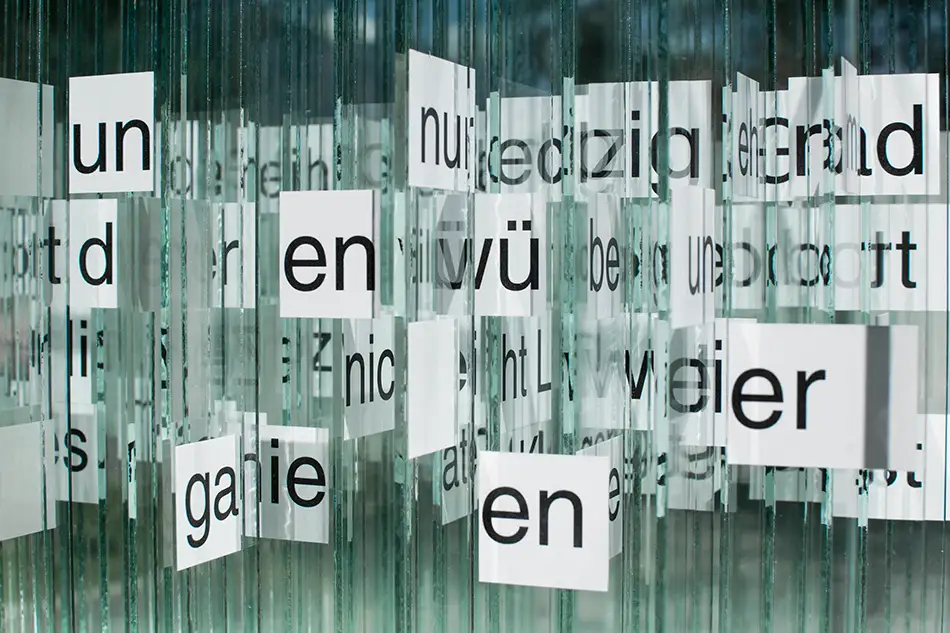
2016 - Take a Seat, Make a Stand!
In densely populated urban areas, there are recurring controversial debates about who is allowed to use the city and how. The high level of acceptance among the population towards a policy of segregation and exclusion is striking. At a local level, this becomes clear, for example, in connection with no-sleeping and begging zones or the accommodation of refugees. However, displacement also takes place when people are forced to move from the centre to the periphery due to rising rents or when there are fewer spaces for young people that do not require them to consume.
In political discourse, there are voices that play these marginalised people and groups off against each other, blaming one group for the displacement of another. In view of the lack of opportunities for marginalised groups to shape society, however, this argument is contradictory and passes on responsibility.
Responsibility can only be claimed where power exists. It is not only in the hands of political decision-makers, but also arises through the accumulation of income and wealth, partly detached from democratic political mechanisms.
The art installation "Take a Seat, Make a Stand!" characterises the massive inequality in the distribution of power and resources as the primary social cause of segregation phenomena. Analogous to the feminist metaphor of the glass ceiling, these structural (and infrastructural) barriers contribute to the stabilisation of a hierarchy that runs counter to the idea of equal opportunities for all.
The intervention makes these invisible boundaries perceptible and aims to encourage people to take a critical stance in the discussion. It presents freely accessible public space as a valuable resource and reveals a dystopia in which the park bench as a place and symbol of participation in urban life only exists as an inaccessible and museum-like object in a display case.
Go to Take a Seat, Make a Stand! project entry.

2015 - 100% Mirror
The pseudo seal of approval with the inscription "THIS MIRROR IS - APPROVED - 100% OBJECTIVE" draws attention to the mirror as such. Although it is an objective reflector of light with its perfectly smooth surface, subjective perception plays a decisive role in its use.
In a way, the mirror can be seen as a symbol for a fundamental epistemological problem: It shows an external view of us, while we can only perceive from our internal perspective.
Go to 100% Mirror project entry.

2015 - Emergence Lab
A transparent cubic framework is created using a plug-in system of 216 laser-cut acrylic glass strips. Countless image fragments are painted onto the surfaces of this basic structure, forming six different images from six orthogonal viewing directions.
In order to avoid disturbing reflections within the stripes and to create the appearance of a solid glass object, the sculpture floats in a special silicone oil that has the same refractive index as acrylic glass.
Its title refers to a phenomenon called emergence. Emergence refers to properties that arise from the interaction of the parts of a system without these properties occurring in its parts.
At first glance, the Emergence Lab imitates this phenomenon: through the reorganisation of the image fragments, the individual image emerges as a new property that can barely be guessed from the previously visible accumulation of image fragments.
However, the emergence of the Emergence Lab can be found in particular on a deeper level: Through the interplay of objectifiable components such as optics, material physics and technical planning, a work of art is created that as such can no longer be reduced to its physical components.
Art in general can thus exist without contradiction alongside the natural sciences, as something physical whose subjective meaning is not to be found in its physical parts.
Go to Emergence Lab project entry.
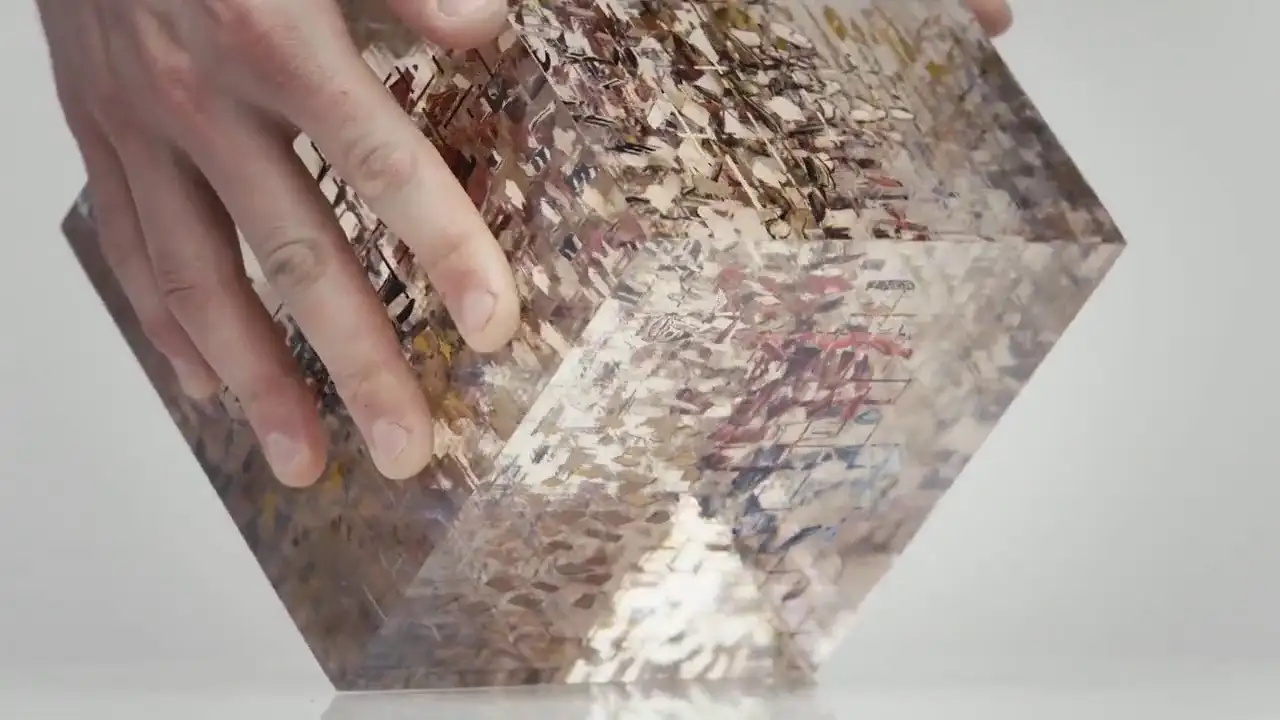
2014 - *** this!
In the *** this! series, different calls to action are linked to ambiguous gestural drawings. They are mostly aimed at thinking further about what is drawn in one way or another: descriptively, methodically, rationally.
The quick sketches explore how art can be described and defined with the help of language. In the attempt to fulfil the request we have read, it becomes clear that every analytical translation of artistic expression does not describe it in its entirety.
The way of interpreting and understanding is given as a prompt in the pictures; in this way, something is anticipated that actually takes place outside the picture: In a sense, art only becomes complete by being perceived and thought. It is thus inseparably intertwined with its counterpart, it is essentially relational.
Go to *** this! project entry.

2014 - Holes
Interview with Karin Pernegger (2023) about the series Holes in general and the painting Holes, Staircase in particular. Carried out as part of the Kunst-Ankäufe des Landes Tirol 2021.
KP: Why are you interested in optical illusion as an element of your drawings?
TM: Optical illusions are closely linked to the theme of perception and cognition. On the one hand, optical illusion is easy to describe and objectify, but at the same time it shows how ambiguous our perception of reality can be and how relevant it is which perspective we take. In this ambivalence, I find the study of optical illusions exciting.
KP: In this context, how do you explain the title Holes, Staircase of your work from 2019?
TM: There is a whole series called Holes. It is centred on eel-like creatures and other animals that move in impossible and geometrically intertwined spaces. The animals move through holes, but they are also always behind these holes. These openings thus become a paradoxical object, and the creatures perform an impossible movement that can only be depicted in the interplay between the two-dimensional paper and the three-dimensional drawing.
KP: Is it intentional that you combine architecture with eels in your drawings?
TM: In terms of craftsmanship, the eel is long and flexible due to its anatomy, which makes it easy to integrate into the pictures. In terms of theme, my work is often about the relationship between human-made spaces and those that existed before humans. Humans are also animals that are dependent on ecological and biological processes, but at the same time we can emancipate ourselves from nature in a way through language and culture. Even if this has many advantages, the destruction of the earth is a clear disadvantage of this alienation, which affects not least ourselves.
As in an optical illusion, we find ourselves outside of "nature" to a certain extent, without ever really being able to leave it.
KP: In your works, the animal-human relationship often refers to the Anthropocene era with the human-made changes to the ecosystem and the extinction of animal species. Does the eel also stand for this in this work?
TM: The image can also be read as a dystopia, in which all that exists are architectural ruins that have been flooded by humans and reclaimed by non-human animals. The animal world has fascinated me from the very beginning of my work, and that makes it inevitable that I also think about ecology and biodiversity.
Go to Holes project entry.

